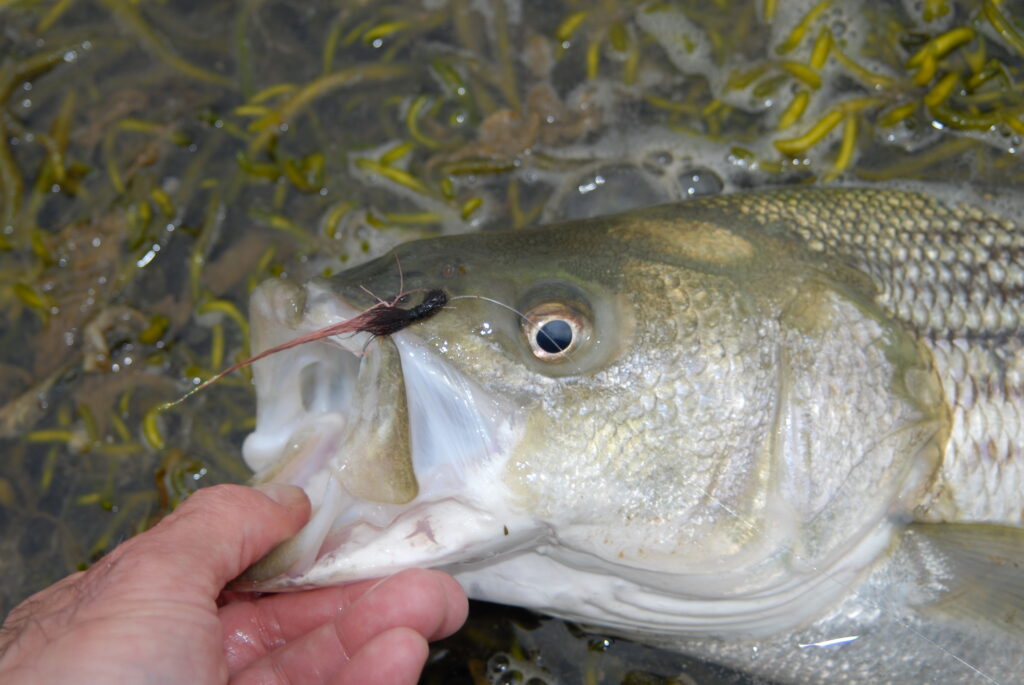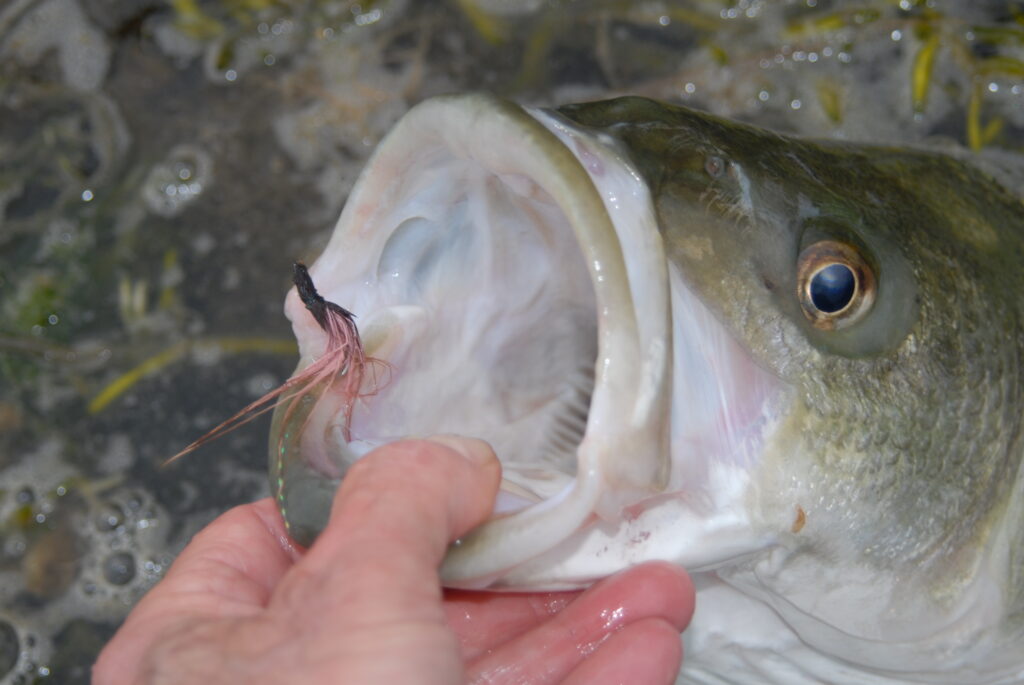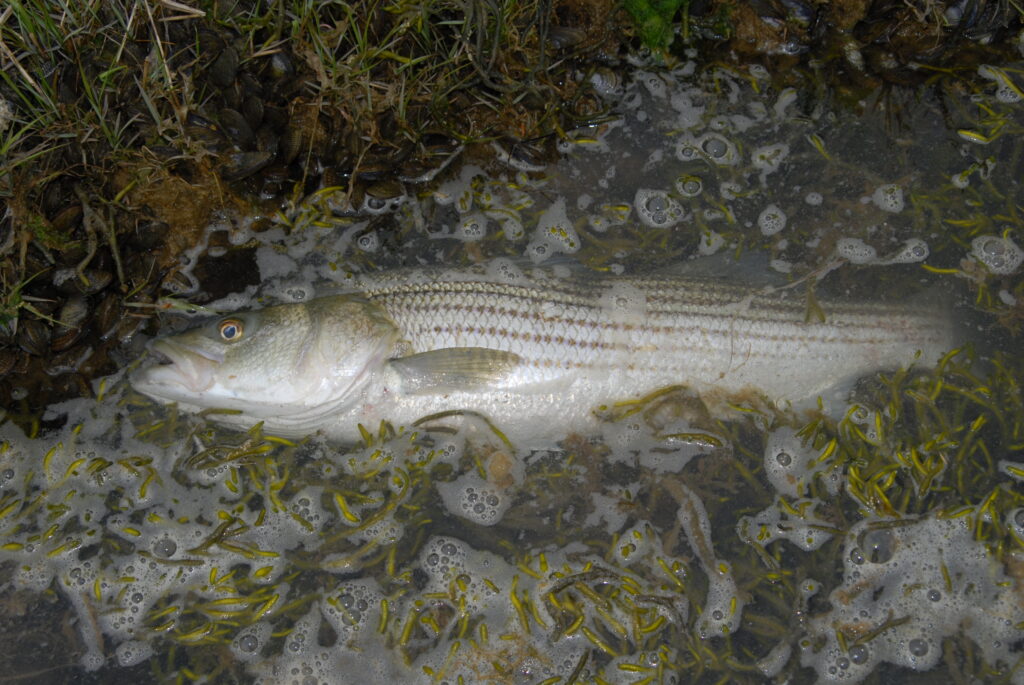Original Saltwater Fly Patterns
I began tying flies over 30 years ago. Is that a long history? Well, yes and no. I believe one could explore the art and science of fly tying for several lifetimes and still have more to know . . . more to learn. It is an immensely creative activity.
Every tyer has a style. Some develop theirs all on their own, but most – myself included – develop a style based on what others have done and follow the paths that others have taken ’till they establish their own personal brand of tying and pattern creation. Glancing over my original patterns, it’s apparent how influential Jack Gartside has been with my concepts and designs. Jack is clearly among the most outstanding pattern creators of our time and I am very glad (and lucky) to have had him as a mentor and friend.
I began fly tying not as a hobby or means to kill time as a young adult, Instead, for me it was an urgent exploration (and need) soon after I had embarked on saltwater fly fishing. I say “urgent” as at that time we were at the early stages of mainstream bonito and false albacore fishing and there was lots of work to be done at the vise to support that burgeoning chapter of the sport. At that same time I was feverishly discovering and deciphering the sport we today call sight-fishing for striped bass – it was the proverbial “blank piece of paper” when I dug into it. A lucky way to begin fly tying, as I see it – the sky was the limit and creativity was a necessity. Do I ever follow prescription and tie mainstream patterns? Of course . . . but the demand for thinking out of the box and free-flowing creativity in my early development forever shaped my approach to continuously explore new materials, techniques, and pattern styles. I encourage all new tyers to boldly do the same.
Disclosure of new fly patterns: I will not publish or demonstrate a pattern until it has been amply tested in the field, modified as required, and proven to be an effective, quality design. This can take (and has with certain patterns) years. Sometimes a fly concept just doesn’t work for whatever reasons and the idea is abandoned. I’ve had more than a few of those. The fly patterns presented on this page have “passed the test” – they’re all based on the five considerations noted below and have proven to be consistently consistent on the water for years.
- Inherent action – The more “life” a fly possesses on its own, the more believable it will be to the fish and ultimately the more consistently successful it will be in fooling them. I strive to instill this powerful attribute in the flies I develop. This is particularly important with crab patterns, which are often paused and left momentarily motionless during the retrieve. A crab fly with life of its own while resting on the bottom is a powerful asset for sight-fishers the world over.
- Simplicity – I strive for simple designs. Why? I personally like quick ties at the vise – less nerve wracking and painful detail makes tying fun and leaves more time for fishing : ) As a former guide, I know that professionals go through some flies on the water – some given to the fish, some to clients, and some just plain destroyed. Quick and effective pattern ties are a guide’s dream-come-true.
- Versatility – Though this is not something I have in mind at the onset of a creative endeavor (usually, my motivation is focused and specific, like fooling a tautog on the flats, or an albacore with a surface fly, etc.) But if I sense a pattern concept has the potential to be a winner with several species, or in a variety of environments, I strive to strengthen that attribute during the fly’s development. The Diablo crab and the Magic Squid are two designs that are extremely versatile fly patterns.
- Adaptability – I really like fly designs that lend themselves to variation and adaptability, including their size, coloration, and weighting among others. Such patterns are convenient and once mastered they enable tyer-anglers a powerful tool both on the water and at the vise. Lefty’s Deceiver and the Wooly Bugger are two well-known examples of “adaptable” pattern designs.
- Cast-ability – To the extent possible, I strive to produce fly patterns that are relatively easy to cast. That is, they do not absorb and hold water when lifted for recasting (this can make them impossibly heavy to launch), they are not stiff and wind resistant, and full-body patterns collapse and become streamlined when wet and out of the water, allowing them to easily shoot through the air.
Magic Squid (1995)
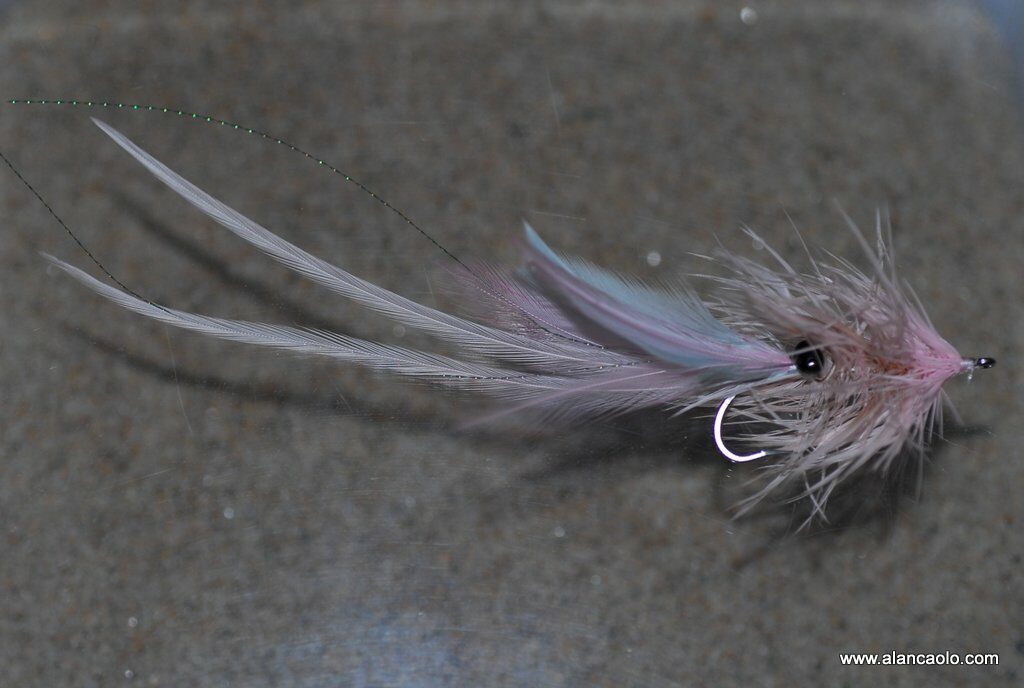
The Magic Squid is my first original pattern. It is an impressionistic squid that entices game fish with its abundant lifelike movement, but it looks pretty squid-like even when motionless in the vise. This is a lightweight and delicate fly that’s intended for calm, shallow inshore waters, rather than deep fast waters, such as rips. Throughout estuaries, bays, and inlets, and over rocks and along sandy ocean beaches, the Magic Squid produces consistently throughout the season . . .
HOOK: Mustad 34011 long shank, size 1 – 1/0
THREAD: White Danville’s Flat Waxed Nylon
TAIL: Two narrow pink hackle feathers, two silver Krystal Flash
HEAD: Two pale pink and one pale blue curved hackle splayed outward on each side
EYES: Large black bead-chain
BODY: Wide pale pink schlappen, palmered
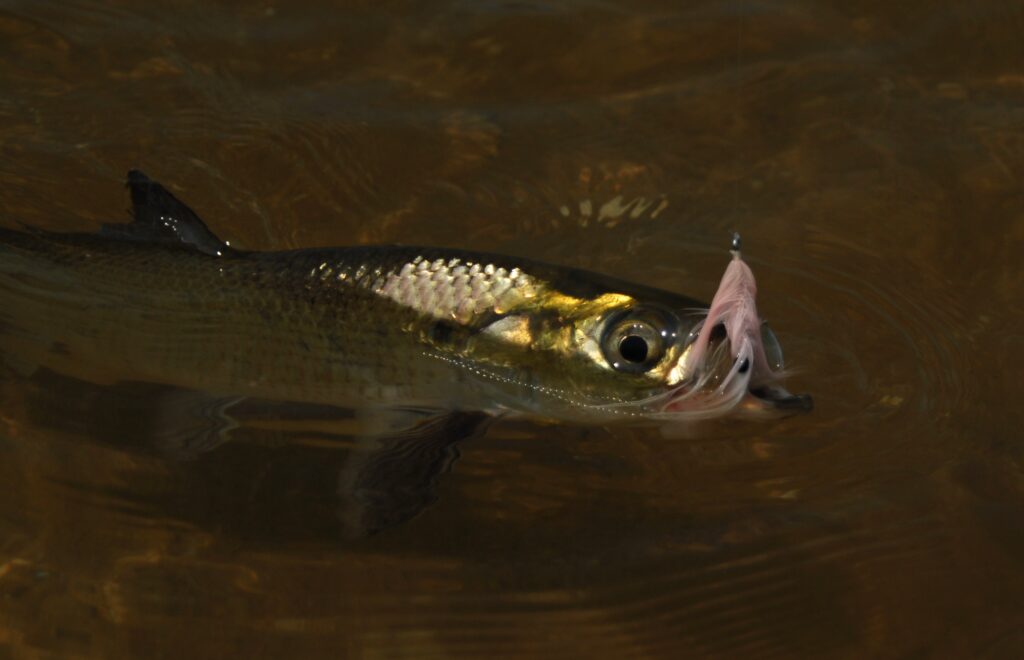
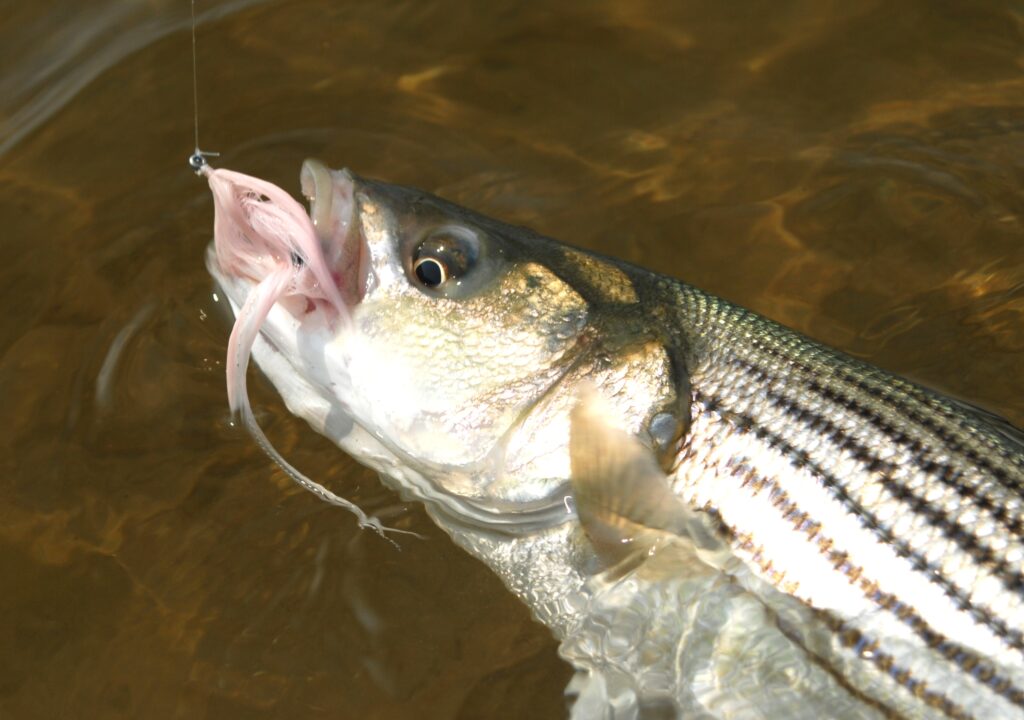
Black Magic (1996)

This is not a new pattern. Shortly after developing the Magic Squid in 1995, I explored variations of the pattern, especially for night-fishing when squid become a powerfully attractive prey for nocturnally feeding striped bass and other inshore game fish. The modifications for nighttime were obvious and straightforward – tie the fly in black or purple, make it a bit larger and fuller to give it a bigger footprint in the darkness, and perhaps use a touch more flash, again to enhance the squid’s “presence”. Additionally, I chose to use bright silver bead-chain in lieu of black eyes (which I prefer for the daytime Magic) to further spark Black Magic’s visibility in the dark. These adaptations for a nocturnal squid fly were immediately successful. Black Magic soon became one of my go-to nighttime striper flies and has held that position in my after-dark flybook for decades.
The formula presented here is my favorite, but other recipe variants have also proven successful, including all-black, all-purple and black and red (similar to the Black Death tarpon fly) where black and red feathers are mixed for the short, curved and splayed head feathers of the squid. Alternating black and purple schlappen (or wide saddles) while palmering the squid body creates a vibrant, pulsating, lifelike impression of the squid undergoing chromatophore excitation that mesmerizingly alters its appearance right before your eyes.
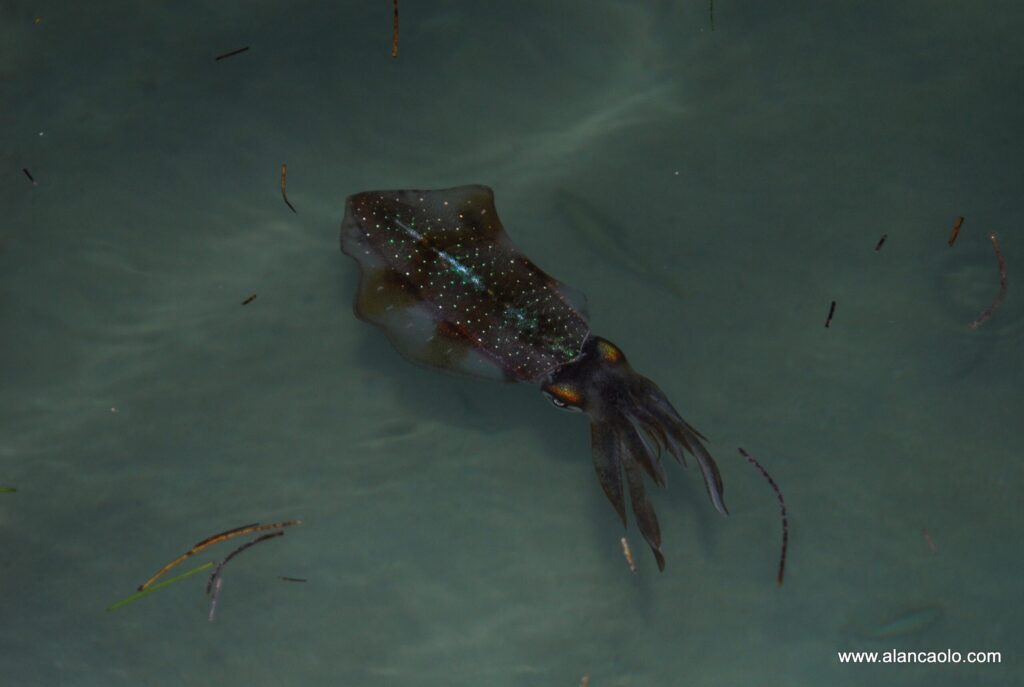

HOOK: Mustad 34011 long shank, size 1/0 – 2/0
THREAD: Black Danville’s Flat Waxed Nylon
TAIL: Two narrow black hackle feathers, two black and two red strands of Krystal Flash
HEAD: Two black and one purple/black grizzly hackles, curved and splayed outward on each side
EYES: Large silver bead-chain
BODY: Wide black schlappen or extra-wide/webby saddles palmered forward from the bead-chain to the eye of the hook
Green Diablo (1996)
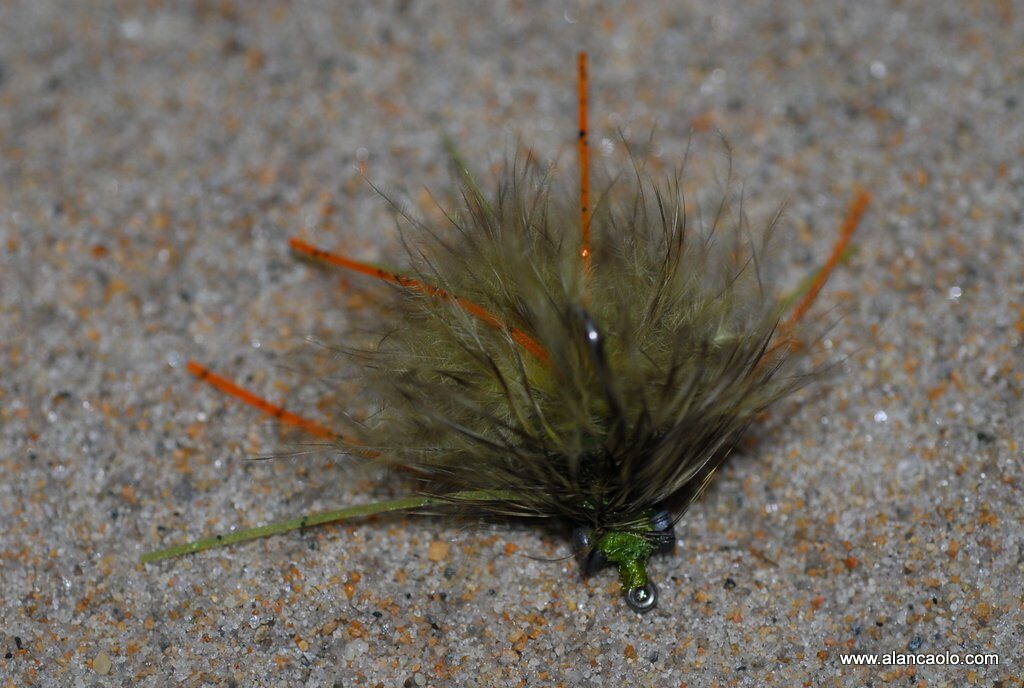
I developed the Green Diablo to address the stark need for effective crab imitations for northern sight-fishing for striped bass – there were none specifically intended for stripers when I began exploring this emergent fishery circa 1990. Early trial patterns were surprisingly similar to the final design, but they were bland and much simpler (I still have them). I knew from a life of striper fishing how important crabs and other crustaceans are to stripers, so I set out to design a fly that was easy to tie, easy to cast, and would fool the fish consistently – especially in estuarine environments. The Diablo was a radical departure in crab fly design in that it is a soft impressionistic pattern with inherent lifelike action, which was quite unlike other, stiffer crab pattern “sculptures” of the era. Not by intent, but in hindsight the Diablo design is remarkably similar to the Wooly Bugger, a freshwater pattern that I acknowledge as the parent of the Diablo Crab design.
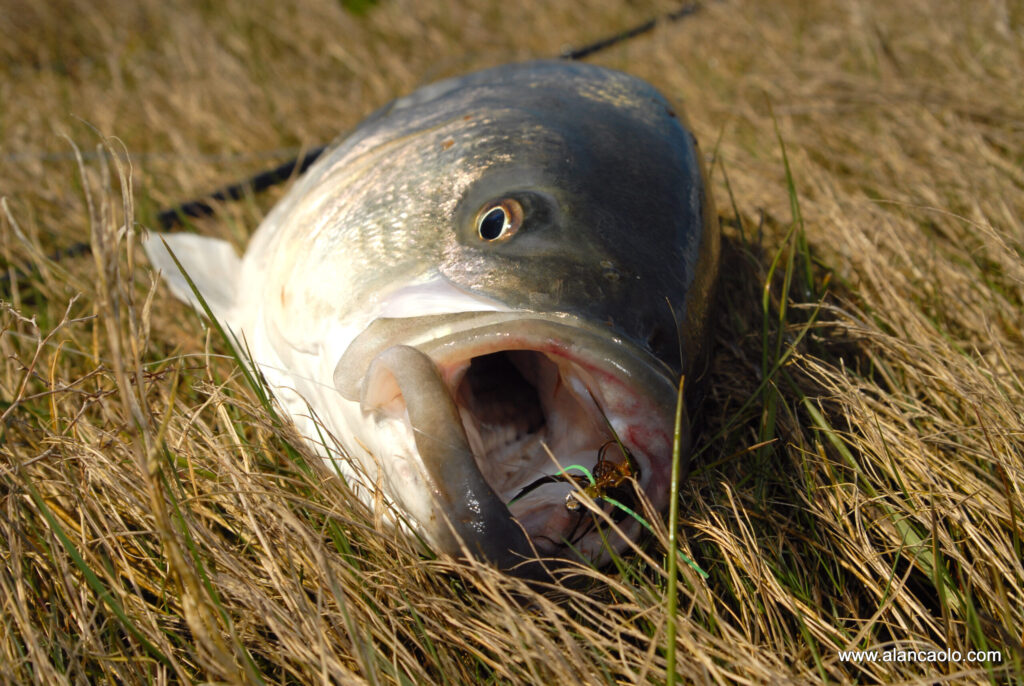
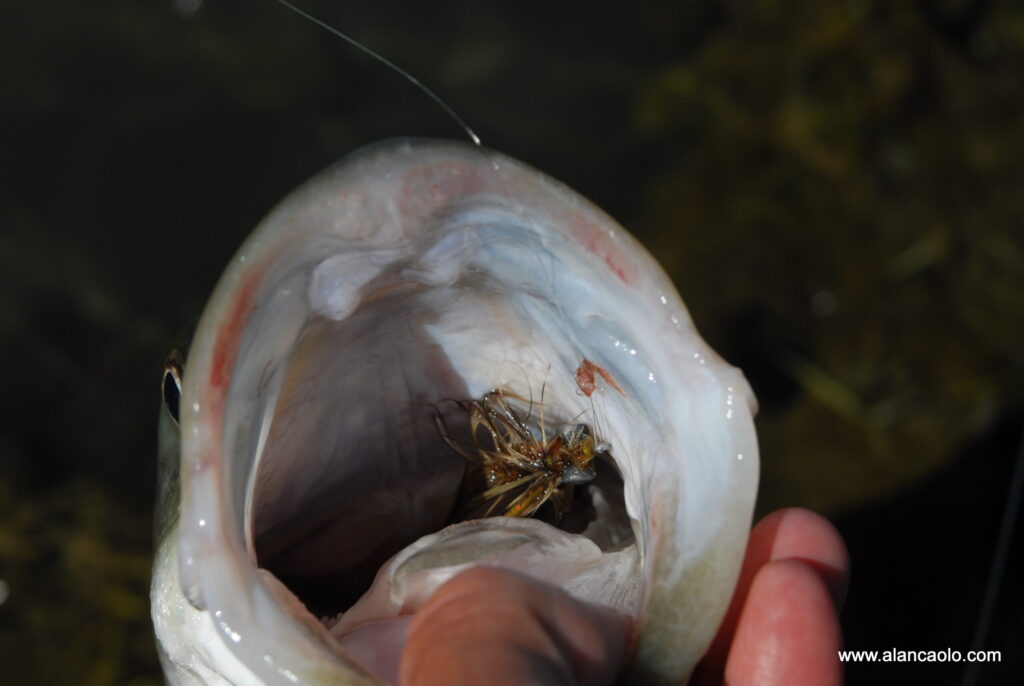
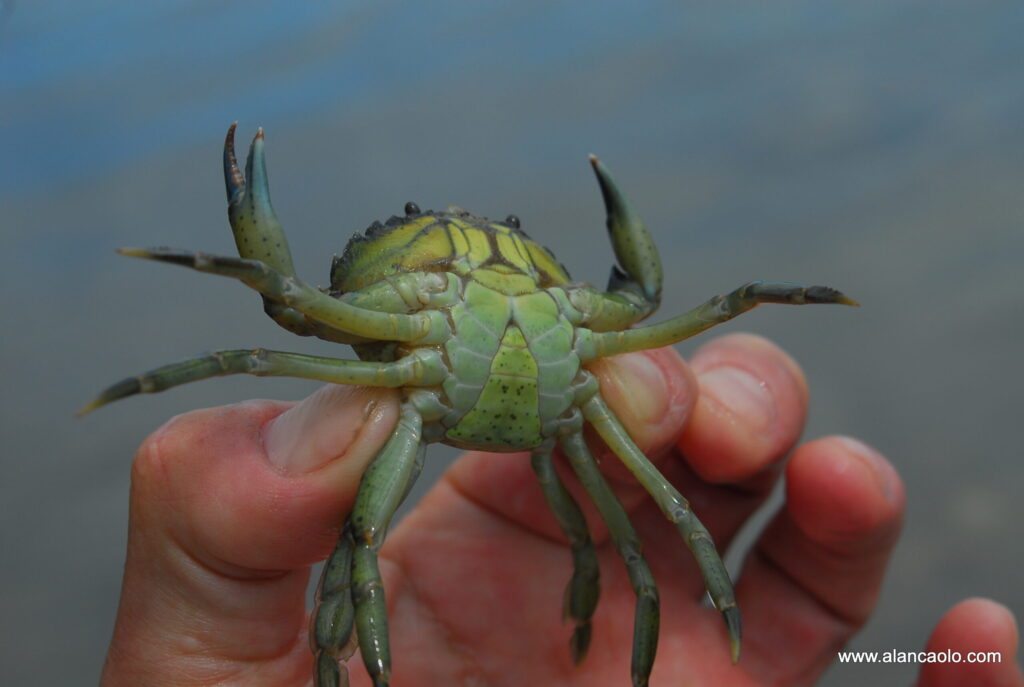
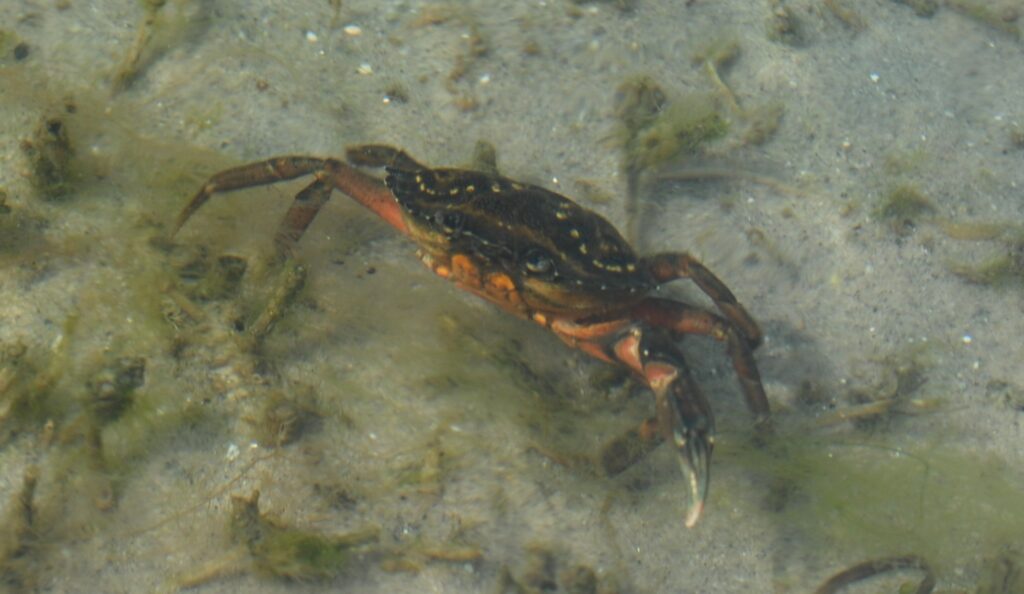
HOOK: Daiichi 2546 or TMC 811S, size 4 – 2
THREAD: Olive Danville’s Flat Waxed Nylon
EYES: Large (1/16 oz) lead dumbbells with bronze coating
TAIL: Olive grizzly schlappen; four mixed Sili-Legs – olive, variegated, lime, black
BODY: Olive or black/olive variegated chenille; olive grizzly schlappen
LEGS: Four Sili-Legs that match tail legs
Mini Diablo (1998)
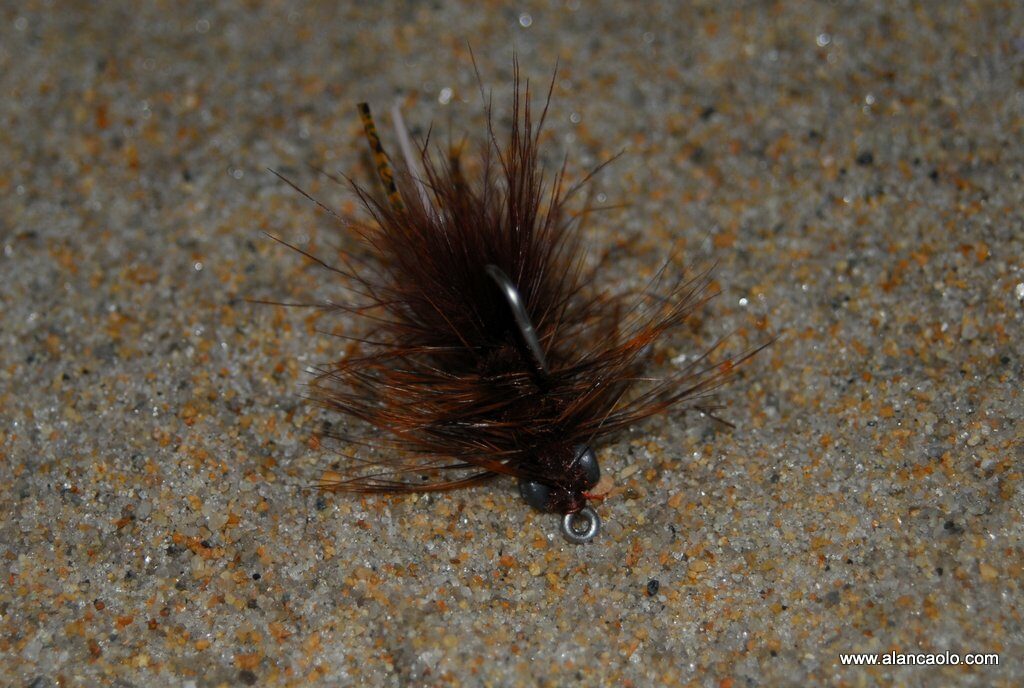
The Mini Diablo is just what its name says it is – a miniature version of the larger Diablo crab design that is intended for larger game fish such as striped bass, permit, snook and redfish. The fly is just as simple to tie and just as potent as the full-size parent pattern, it’s merely intended for game that favors smaller crabs, such as bonefish, sheepshead, summer flounder, tautog, pompano, snappers and small permit. Myriad color combinations and options are open to tyer creativity and game fish preference. I generally stick to a tan, brown or green theme and spice up the appearance with the limitless section of rubber and silicone legs on the market today.
HOOK: Daiichi 2546 or TMC 811S, size 6 – 4
THREAD: Tan or brown Danville’s Flat Waxed Nylon
EYES: Medium bead-chain with bronze coating
BODY: Brown or tan medium chenille; brown or tan schlappen
TAIL: Soft brown saddle; two motor oil or white Sili-Legs
Pink Lady (1995)

The Pink Lady is another unique design in the realm of crab patterns – this is a swimming crab that’s designed to be retrieved steadily (at times quickly) to mimic the fleeing behavior of crabs capable of fast and agile swimming, such as lady (or calico) crabs and blue crabs. Presentation is much more like the steady retrieve of a weighted baitfish fly, such as a Clouser Minnow, than the tentative, stop-n-go approach used with traditional crab flies. The Pink Lady was developed to address a unique and difficult challenge – fooling large striped bass along open ocean sand beaches throughout the Northeast. It is a successful design that netted both the 2- and 4-pound-test IGFA tippet records in the summer of 1997.
HOOK: Daiich 2546 or TMC 811S, size 2 – 1/0
THREAD: Shell Danville’s Flat Waxed Nylon
EYES: Large lead barbells painted pink with purple flecks
BODY: Bill’s Body-Braid, pearl; ginger grizzly hackles; pink schlappen
TAIL: Four ginger grizzly hackles, splayed, two per side
Sole Merkin (1997)
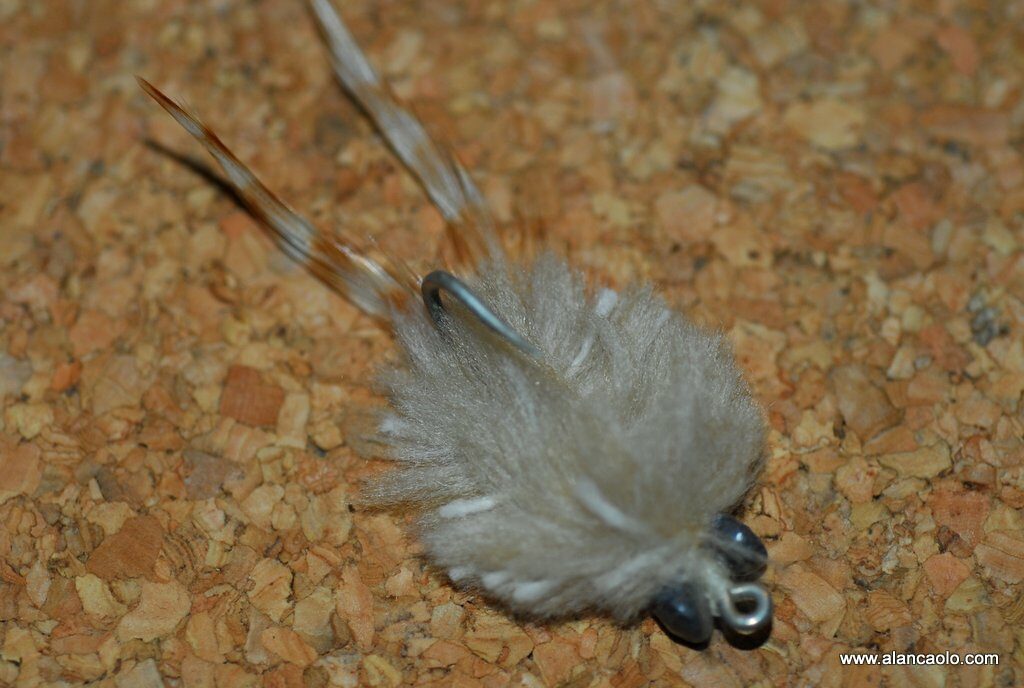
The Sole Merkin is another unique pattern that was developed to meet the challenges of the emerging Northeast sight-fishing sport that was discovered and explored in the ‘90’s, that miracle decade for striped bass fishing on the Atlantic seaboard. As its name and appearance clearly suggest, this pattern is a juvenile flounder imitation that was immediately successful in duping stripers feeding on baby flounder in estuaries and bays throughout the Northeast. Well aware of the importance of baby flounder in the striper’s diet and anxious to capitalize on this opportunity, I jumped to a quick solution – simply modify the late Del Brown’s fantastic permit fly – The Merkin – by removing its rubber legs, eliminating the bright tail flash, and substituting soft sweater yarn rather than carpet yarn for the body construction, and the Sole Merkin emerged and was an instant hit.
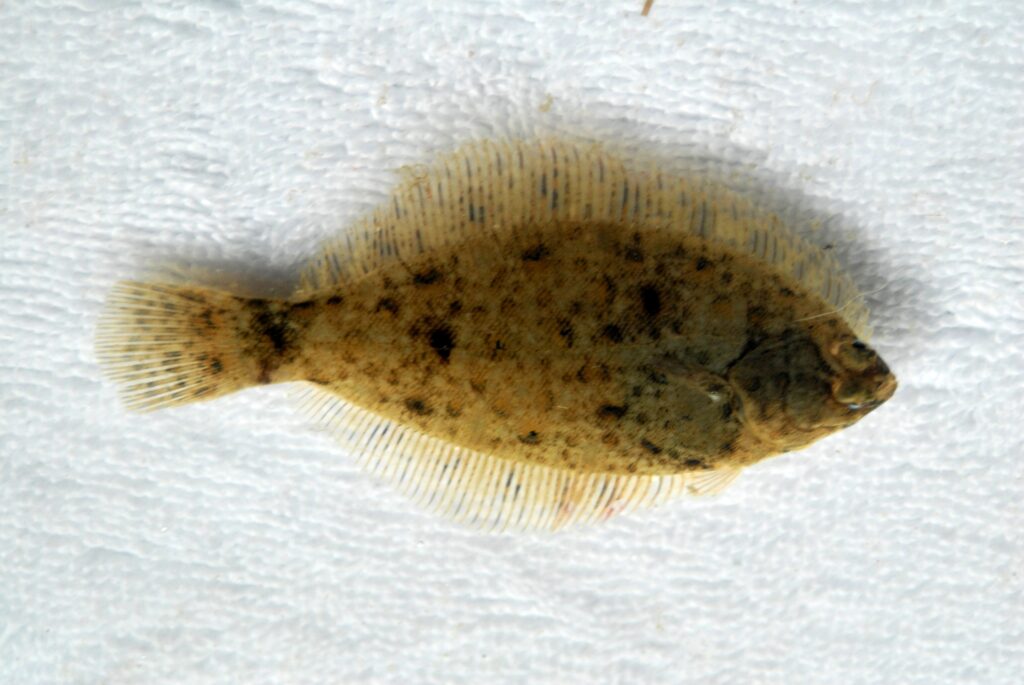

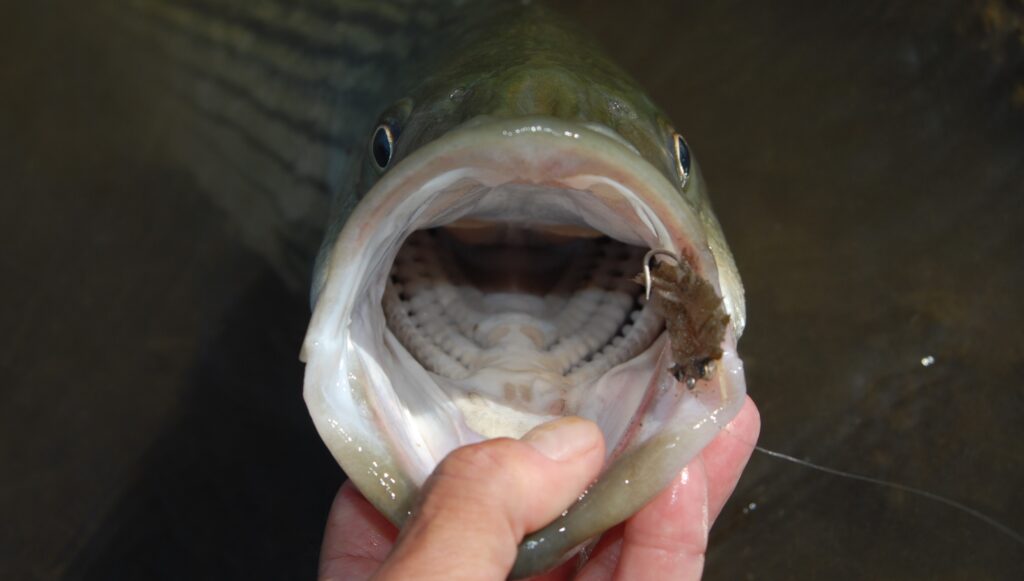
HOOK: Daiich 2546 or TMC 811S, size 4 – 1
THREAD: White Danville’s Flat Waxed Nylon
EYES: Medium (1/24 oz) lead dumbbells with bronze coating
TAIL: Two curved, splayed narrow crème hackles; crème aftershaft feather, palmered
BODY: Soft crème or tan sweater yarn shaped oval and flat to a flounder profile
Bahia Bug (2007)

This pattern is an evolution of a smaller version of my incredibly effective Pink Lady swimming crab imitation. The original “small” Pink Lady utilized two stubby saddles tied flat on the top of the fly to create the carapace and it was an effective pattern to mimic young-of-the-year calico crabs. This part of the fly was replaced with a spun schlappen feather at the eye of the hook with some marabou tucked in underneath. This modification added a great deal more inherent “life” to the pattern (an element of crab fly design that I consider extremely important for all successful crab patterns). This, along with the addition of silicone legs to the tail, combined to make this fly pattern a consistently successful imitation of not one, but two crab species – small calico crabs and mole crabs – which frequently cohabit-ate the inter-tidal zone along sandy beaches. This “duel imitation” give this crab fly a one-two punch along Northeast ocean beaches.
HOOK: Daiichi 2546 or TMC 811S, size 4 – 1
THREAD: Shell Danville’s Flat Waxed Nylon
EYES: Medium (1/24 oz) or large (1/20 oz) lead dumbbells
TAIL: Pale pink schlappen; four clear Sili-Legs with red/black flecks; four gold Krystal Flash strands
BODY: White medium chenille
CARAPACE: Pale pink schlappen, palmered; white or pink marabou
Witch Doctor (2006)
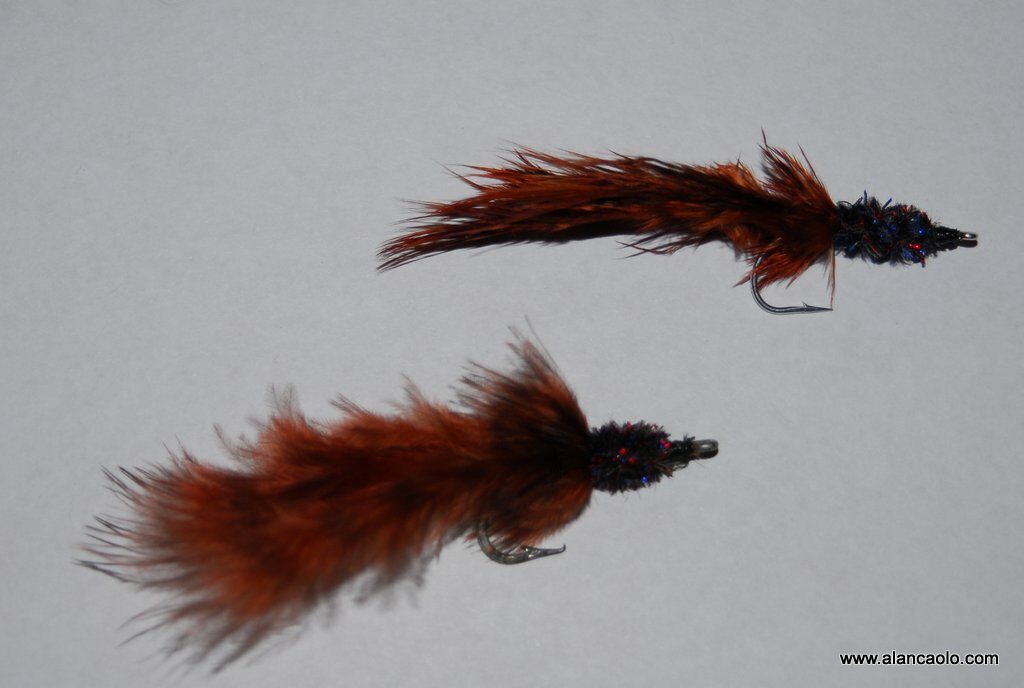
There are many good cinder worm patterns out there and on any given day any or all of them can succeed. So what was the motivation to develop this fly? Simple curiosity . . . could I find a simple and effective design that would succeed most of the time (I don’t know of any worm flies that work all the time). The Witch Doctor is about as simple a pattern as there is and it works . . . most of the time. The fly derives its delicate worm-like movement through the use of aftershaft feathers – the “junk” feathers along the back base of a hackle neck. Once familiar with the pattern, a Doctor can be produced in about three minutes. The Witch Doctor may be fished in tandem or alone, but always on a light monofilament leader of eight- to ten-pound-test.


HOOK: Gamakatsu SS-15 or Daiichi 1750, size 6 – 4
THREAD: Black Danville’s Flat Waxed Nylon
WING: Single 1”-wide rust/black grizzly aftershaft feather, flat
COLLAR: Single 1”-wide rust/black aftershaft feather, palmered
HEAD: Black medium sparkle chenille (plain black is fine, too)
Beach Bug (2008)
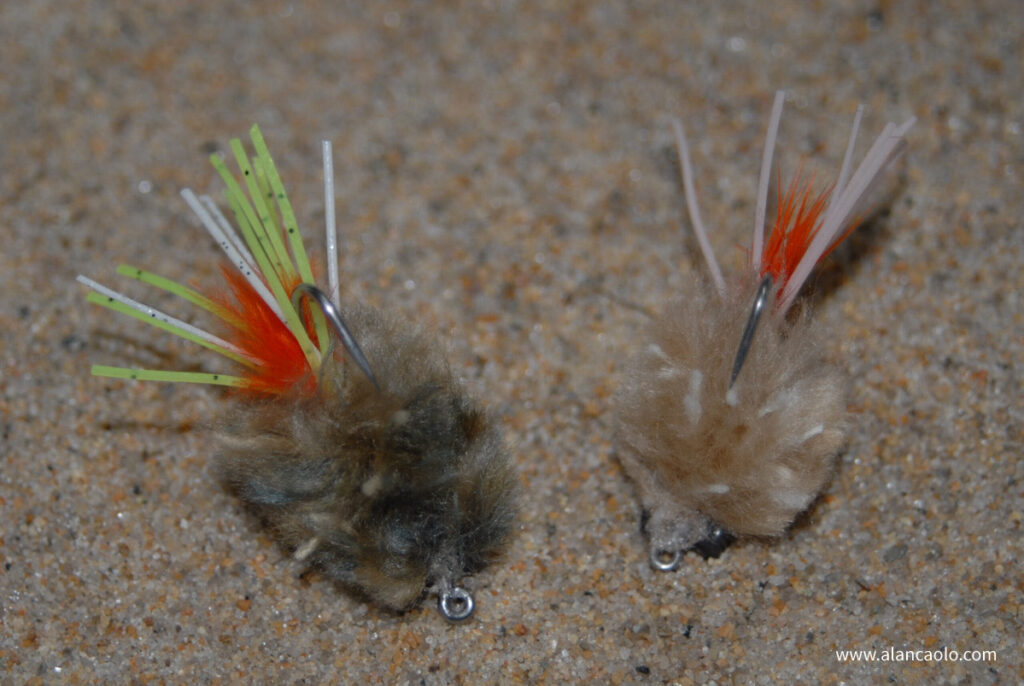
Yet another crab pattern developed to fill the relative dearth of flies for the emerging striped bass sight-fishery. In the early and mid-90’s there were Clouser Minnows and Half-n-Halfs (essentially a Clouser with a couple of feathers included in the tail . . . half Clouser – half Deceiver). Over the years, several prey-specific designs emerged for shrimp, crabs, and flounder that opened the doors to this fishery and made success on the flats far more common. The unique and obscure mole crab (Emerita talpoida) proved to be a very important food source for stripers, especially along open ocean sand beaches. But as simple as this little creature is in appearance, it is a tyer’s challenge reproduce at the vise in a form that consistently deceives the bass. The Beach Bug has several tying steps, but it is not a difficult pattern to tie . . . and it fools the fish again and again . . .
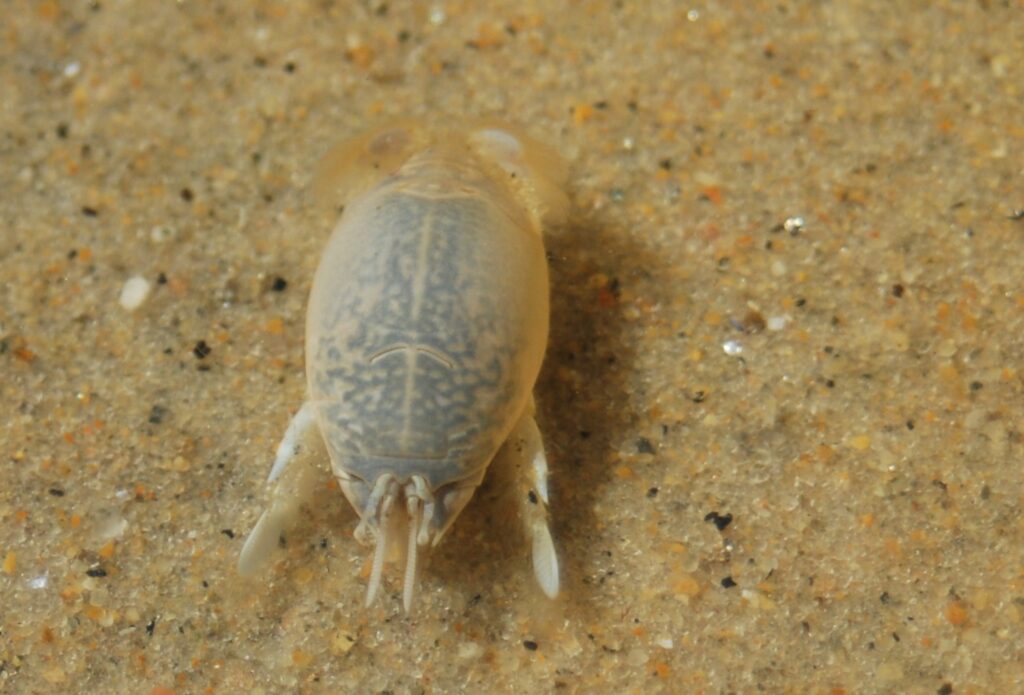
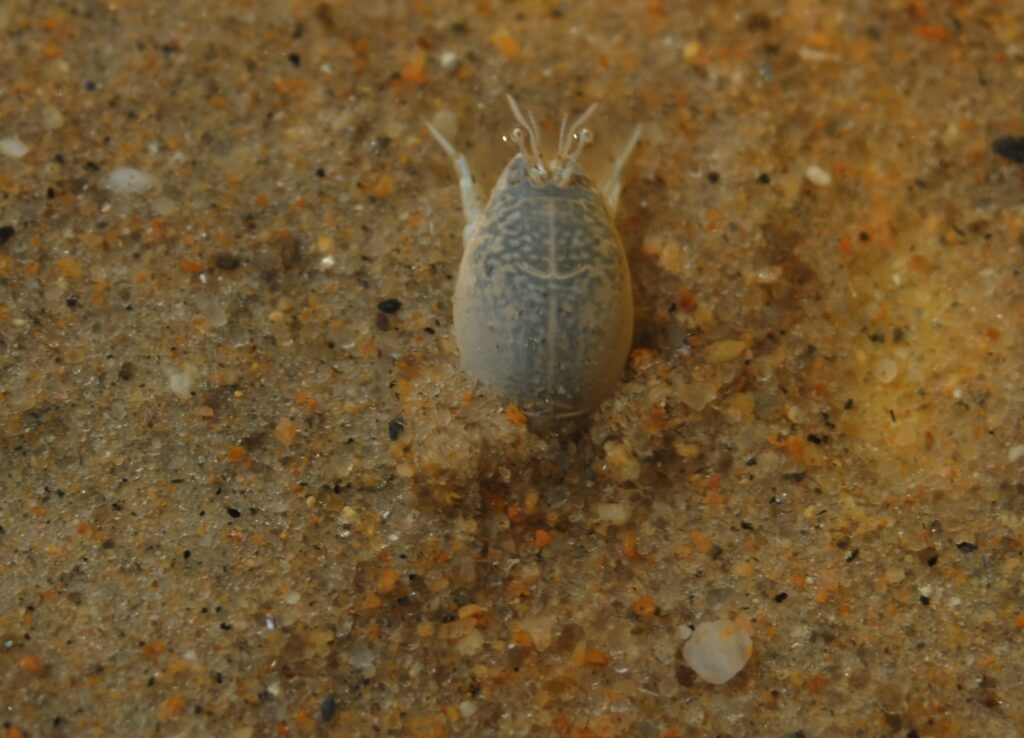
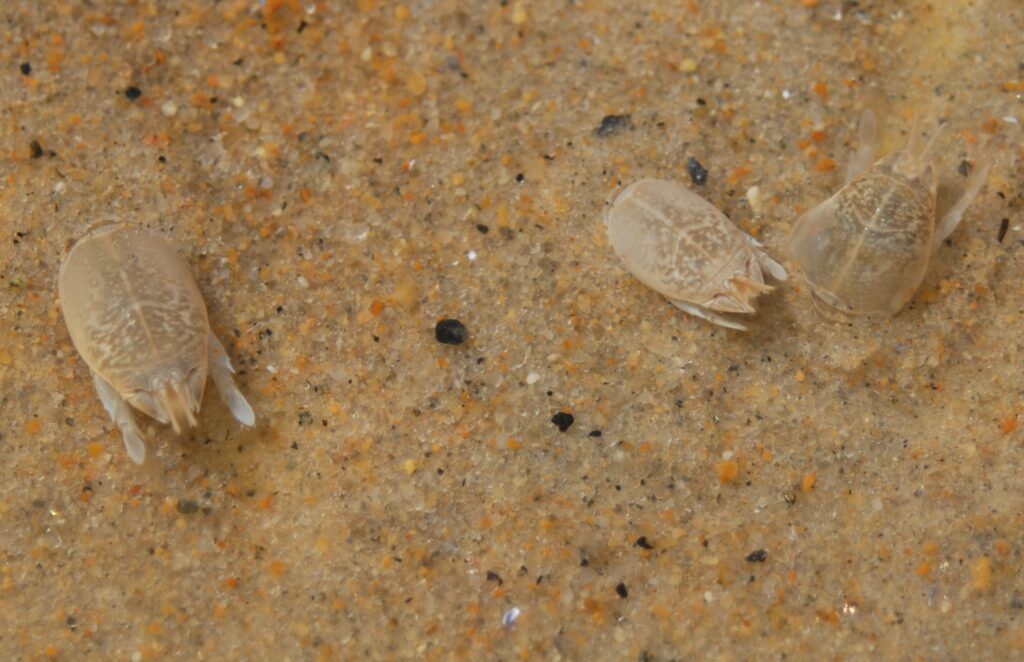
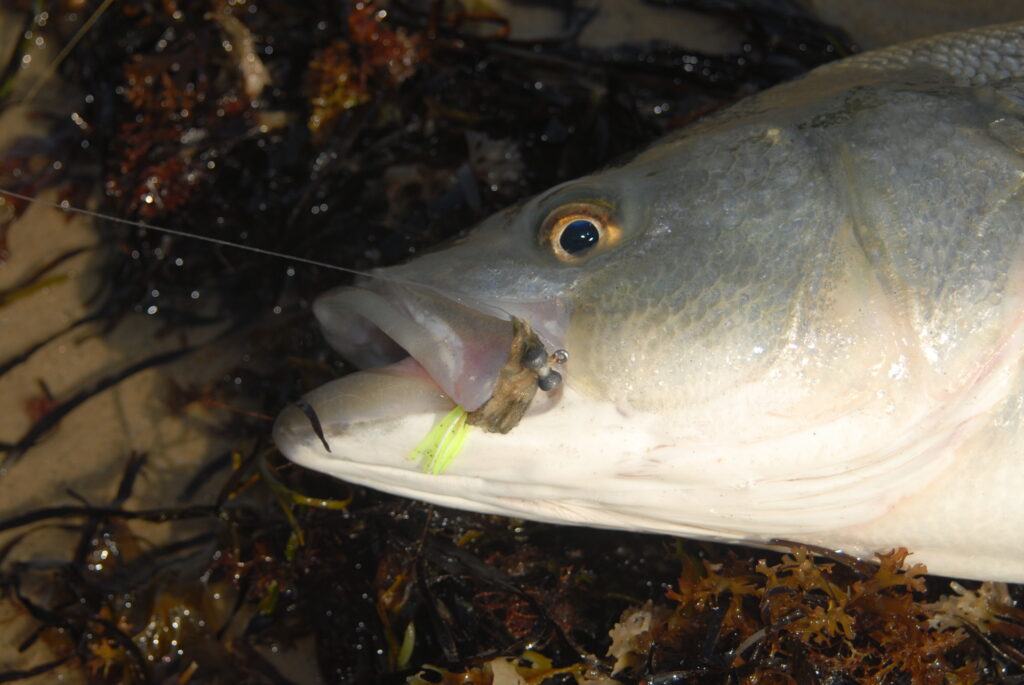
HOOK: Daiichi 2546 or TMC 811S, size 4 – 2
THREAD: White Danville’s Flat Waxed Nylon
WEIGHT: 1/30- to 1/24-ounce black lead dumbbells
TAIL: 10 mixed Sili-Legs, white, chartreuse, flesh, others; orange hen hackle fibers
BODY: Soft olive, gray or tan sweater yarn shaped to oval profile
Modified Beach Bug (2024)
While searching the internet for mole crab imitations, I discovered some nice patterns that I had not seen before – one by well known west coast angler, Al Quattrocchi, who has great success with his pattern while sight-fishing the Pacific surf for corbina, a very challenging game fish. Another mole crab that caught my eye was developed by Mike Cline, who fishes the south Florida surf for pompano and other species fond of the abundant mole crabs along those beaches. What struck me immediately was that both tiers incorporated an egg-cluster in their patterns, a feature that appears on females of the species. They both correctly positioned it toward the rear of their imitations, where the crab’s excavator-like “digger” is situated. This translates to the front of the pattern, near the eye of the hook where the dumbbells are attached. Yours truly had it backwards – I don’t know what I was thinking when I incorrectly mimicked the crab’s egg-cluster with bright orange hen hackle within the pattern’s rubber leg cluster by the bend of the hook. This is effectively the front of the crab, not its back end where the egg-cluster naturally appears. So, I’ve modified the Beach Bug to reflect an anatomically correct mole crab with the egg-cluster situated at the rear of the crab, tucked beneath the lead dumbbells. I simply used bright orange synthetic fleece, rather than the sweater yarn, for my final yarn attachment making sure it was oriented downward to correctly reflect an egg-cluster that’s positioned beneath the mole crab


HOOK: Daiichi 2546 or TMC 811S, size 4 – 2
THREAD: White Danville’s Flat Waxed Nylon
WEIGHT: 1/30- to 1/24-ounce black lead dumbbells
TAIL: 8 mixed Sili-Legs, white, chartreuse, flesh, or others
BODY: Soft olive, gray or tan sweater yarn and bright orange synthetic fleece (egg-cluster) shaped with scissors to an oval profile
Assassin Shrimp (2007)
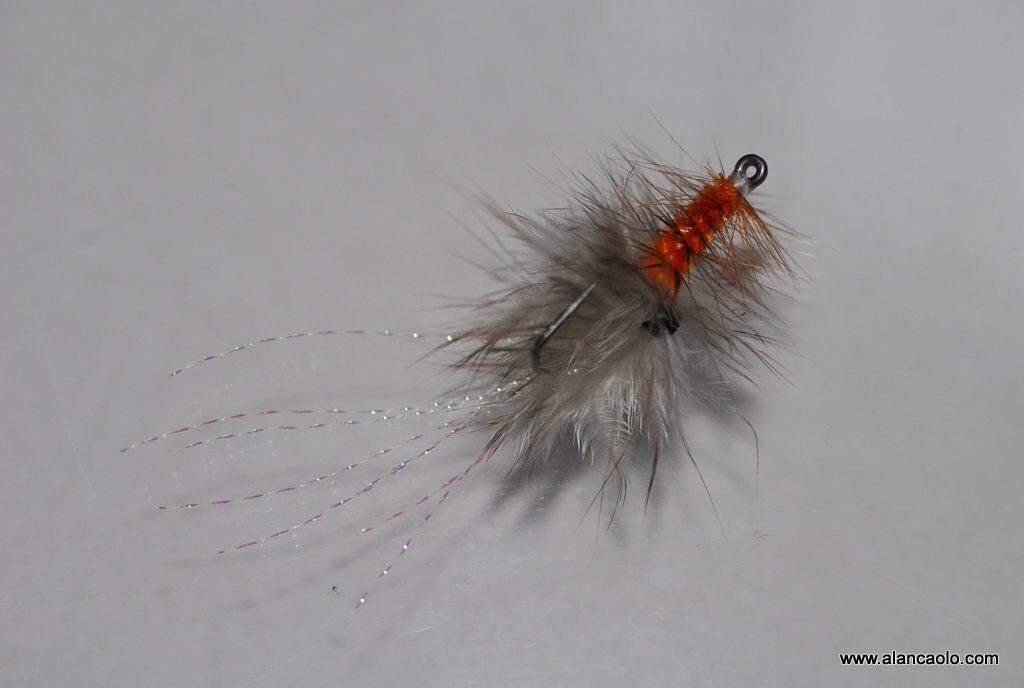
The Assassin Shrimp is a remarkably versatile shrimp pattern that is effective on many saltwater game fish, including striped bass, tautog, seatrout, weakfish, snappers and bonefish. This lightly-weighted simple shrimp imitation may be fished on the bottom in shallow water where it’s an ideal choice for sight-casting to stripers, bonefish or tautog, or it may be fished blind at mid-depth where it is a reliable fly choice for striped bass throughout the spring and summer in protected inshore waters, such as estuaries, bays and harbors. The Assassin Shrimp rides hook-point-up, making it somewhat snag-proof and perfect for blind-casting grass beds in morning and evening low-light periods. The Assassin mimics both sand and grass shrimp that are found throughout the inshore waters of the Northeast.
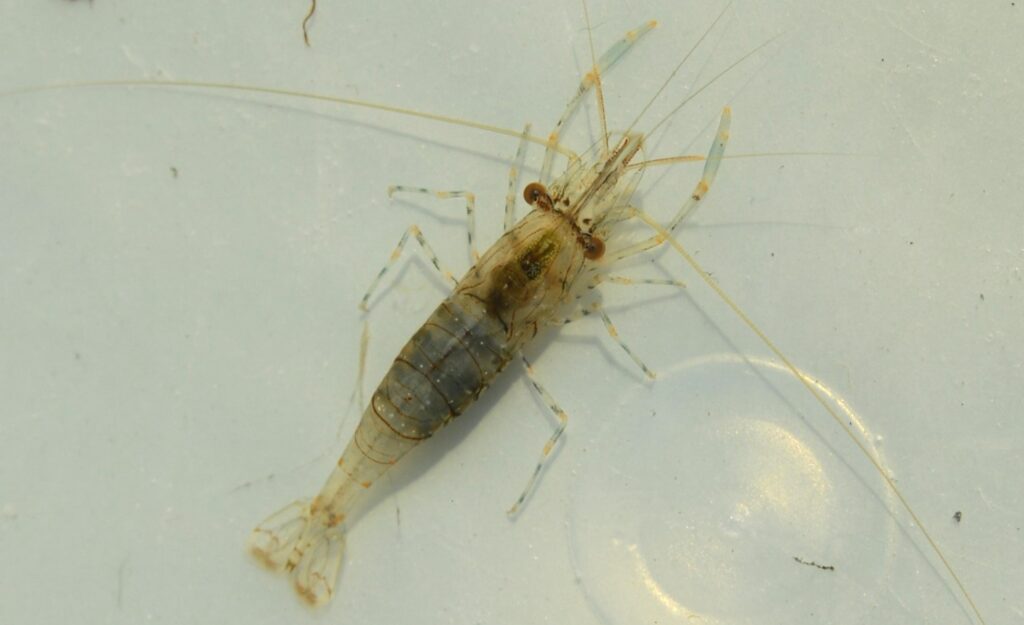

HOOK: Daiichi 2546 or TMC 811S, size 6 – 2
THREAD: White Danville’s Flat Waxed Nylon
ANTENNAE: Pink, peach or yellow Krystal Flash
COLLAR: One soft gray after-shaft feather, palmered
EYES: Medium black bead-chain
BODY: White or apricot medium chenille; one ginger grizzly hackle feather, palmered
Tailing Striper Fly (2000)
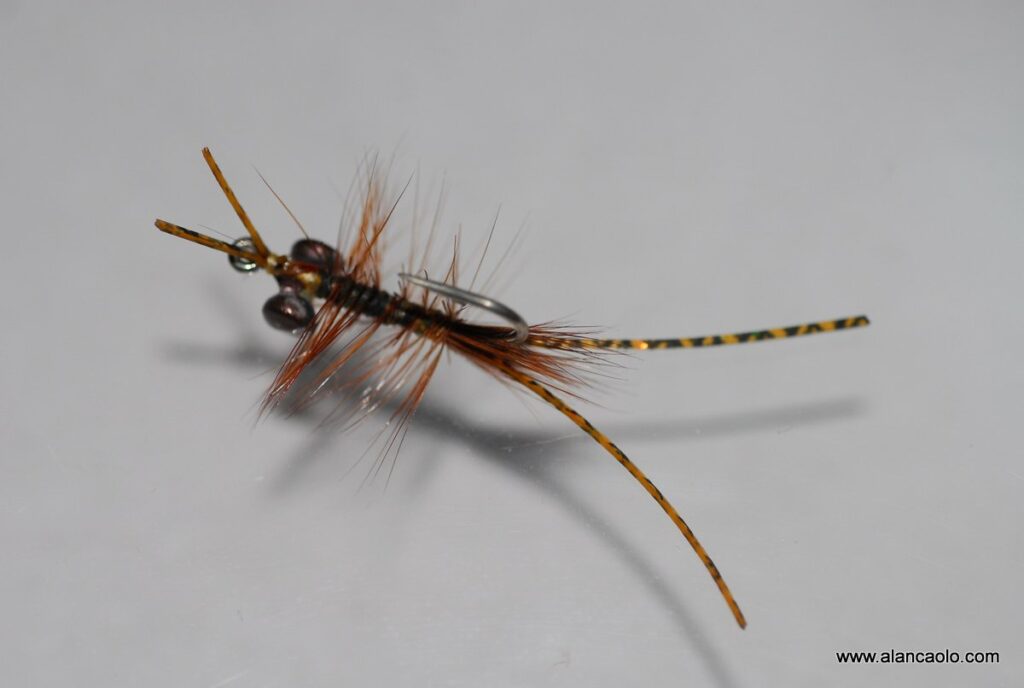
Like the Witch Doctor, the Tailing Striper Fly (TSF) is about as simple as it gets in saltwater fly tying. Literally, a silicone leg, a short narrow hackle, and small dumbbell eyes are all the material you’ll need to make one. As indicated by its name, the TSF is another pattern intended for sight-fishing stripers on the flats . . . where they do indeed tail like bonefish. Though this is not everyday feeding behavior, it is prevalent in the months of June and July throughout shrimp-rich inshore waters, such as estuaries and bays. Sight-casting to tailing fish (of any species) is one of the hottest thrills in outdoor sports. With the right presentation the TSF cracks the code and gets you connected. This is a small weighted shrimp imitation intended to be positioned on the bottom ahead of the fish and played with a very subtle retrieve – twitches, nudges, maybe a short hop . . . and nothing more. The strike is delicate – nothing more than a quick tap.
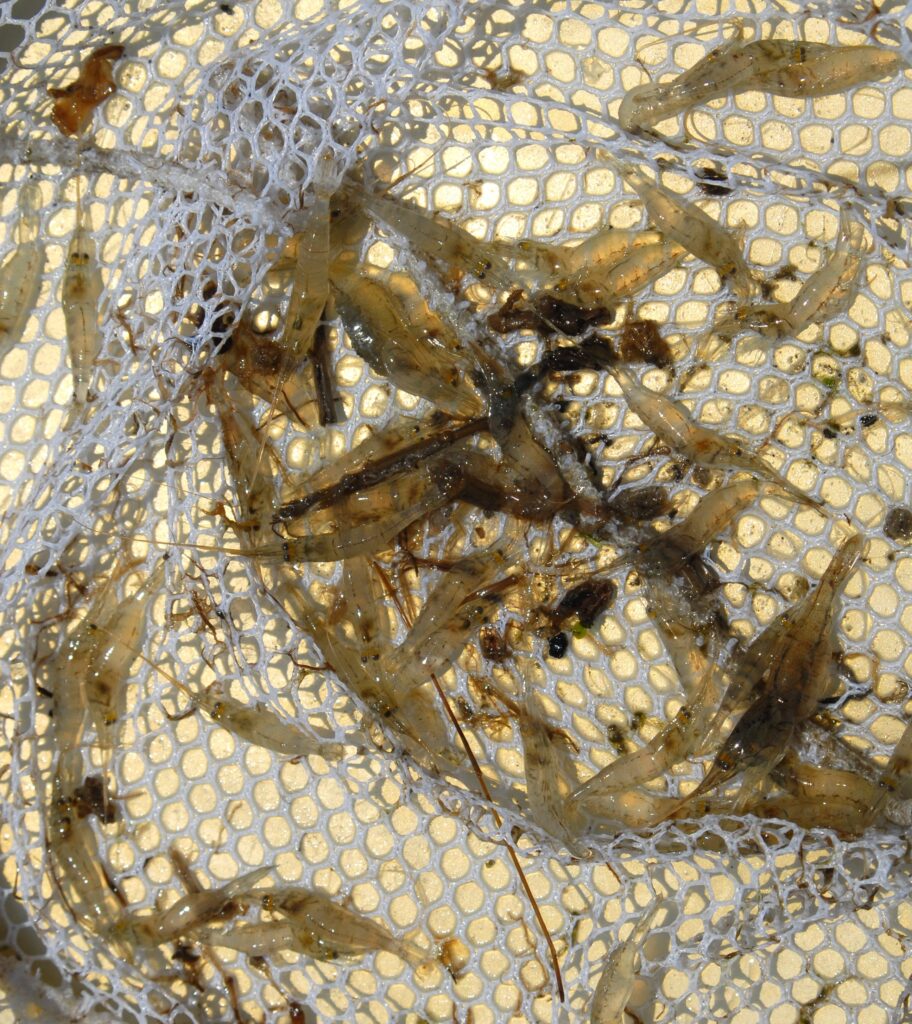
Modified Tailing Striper Fly (2023)
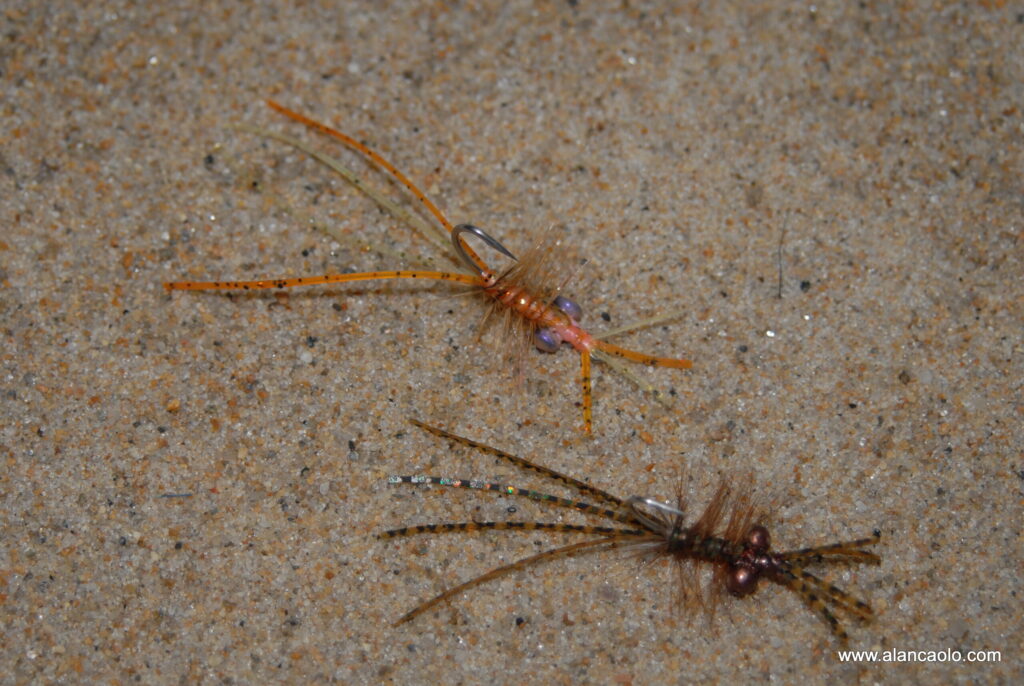
I developed the Tailing Striper Fly (TSF) over 20 years ago to reliably take summer stripers that were focused on sand shrimp, a small bottom-dwelling crustacean that’s present throughout our inshore waters (bays, salt ponds, estuaries, etc.) year-round. But bass become noticeably focused on these shrimp during June and July when the flats are warming up and shrimp are concentrated there and they become very important flats forage for stripers. Small bottom-working shrimp patterns are sometimes the only flies the fish will take during this phase of the flats fishing season. Will other small saltwater fly patterns succeed with shrimp-obsessed striped bass? Yes, Crazy Charlies, Gotchas (two well-known bonefish patterns) and small Clouser Minnows in size 6 and 4 will work, but the TSF is formulated specifically for striped bass selectively feeding on Northeast flats.
As the pattern name suggests, striped bass regularly do tail on shrimp, often creating a “mud” similar to bonefish when several bass are in close proximity working a shrimp bed. Sand shrimp prefer softer sediments that tend to produce such a mud. The water depth in which they’re feeding is the factor determining whether the bass will “tail” or merely be observed tipped down as they peck at the bottom of deeper flats. You will also observe singles and pairs meandering over the flats, periodically pausing and nosing down for a shrimp or two (they often twist and “flash” when they do this) . . . these bass are hyper selective and can very difficult to take.
Why the updated design? My penchant for hardcore spartan simplicity in pattern design appears to have softened in my old age. Adding a bit of zest to the TSF with longer rubber legs and mixing colors instead of the singular motor oil theme produced a fly with enhanced movement (action) that’s still quick and simple to tie. But as with the original TSF, the motor oil color theme is still “lights out” on tailing and mudding striped bass.

HOOK: Daiichi 2546 or TMC 811S, size 6 – 2 (size 4 – 2 for the Modified TSF)
THREAD: Tan or white Danville’s Flat Waxed Nylon
WEIGHT: Medium bead-chain or small lead dumbbells with sand or bronze nail polish coating
TAIL: Two motor oil Sili-Legs, long and splayed (four Sili-Legs for the Modified TSF)
BODY: Motor oil Sili-Leg (wrapped); narrow ginger hackle palmered
ANTENNAE: Two motor oil Sili-Legs, short and splayed (four Sili-Legs for the Modified TSF)
Flying Monkey (2008)

The Flying Monkey is probably the most unusual and innovative fly I’ve concocted to date. This is a crab imitation and it is unique. It’s another swimming crab pattern that mimics both the fleeing behavior and stationary defensive posture of these crab species remarkably well. The pattern is heavily weighted at the eye of the hook while the body is composed of buoyant spun deer or elk hair toward the rear of the fly (back toward the hook point and bend). When the fly is stripped, it darts away – along the bottom – in a horizontal swimming posture with the two leg/claw feathers fluttering in an enormously lifelike fashion behind the crab. When the fly is paused on the bottom, the buoyant carapace rises upward with the two leg/claw feathers slowly waving with an upward posture while the heavy lead eyes keep the eye of the hook oriented downward and on the bottom – the fly essentially stands vertically on its nose when paused, and suddenly assumes a horizontal position when stripped as it flutters away . . . This fly is nasty. The Flying Monkey has become my go-to pick when I see big bass prowling sand bottoms for lady (or calico) crabs. The Flying Monkey is also effective for imitating other swimming crabs, such as blue crabs, which are found throughout western Atlantic inshore waters and flats from New England south through the tropics.
Recipe for Lady Crab Imitation
HOOK: Daiichi 2546 or TMC 811S, size 2 – 1/0
THREAD: Tan Danville’s Flat Waxed Nylon
WEIGHT: 1/20-ounce lead dumbbells, with bronze coating
EYES: Burnt 30-pound-test monofilament (optional)
BODY: Tan or beige spun deer or elk hair; gold Krystal Flash
CLAWS: Two narrow ginger grizzly hackles, splayed outward
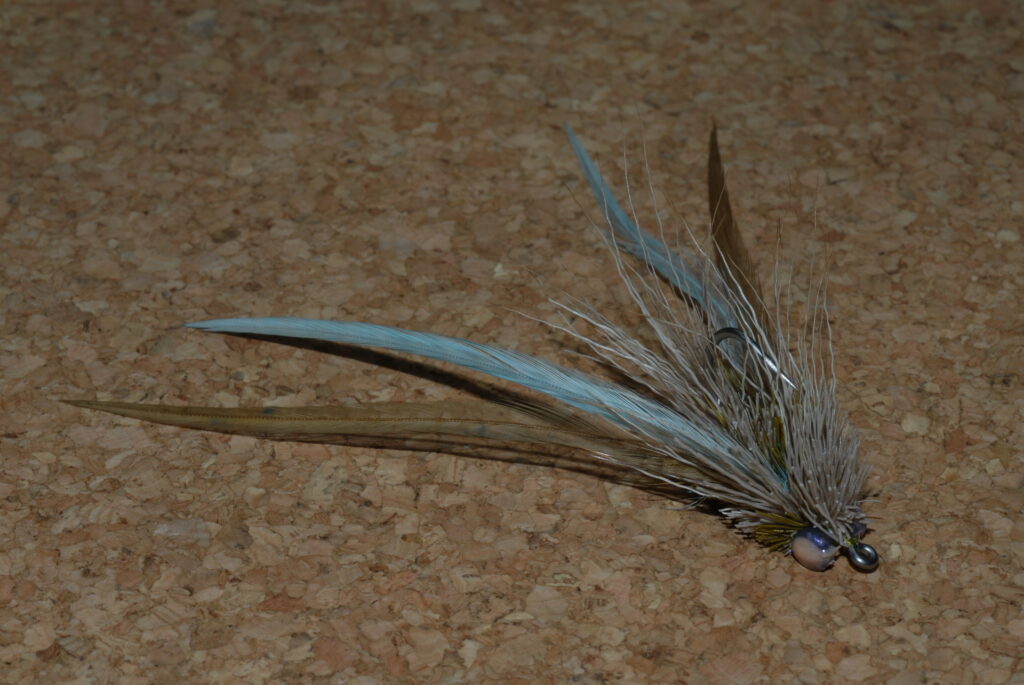
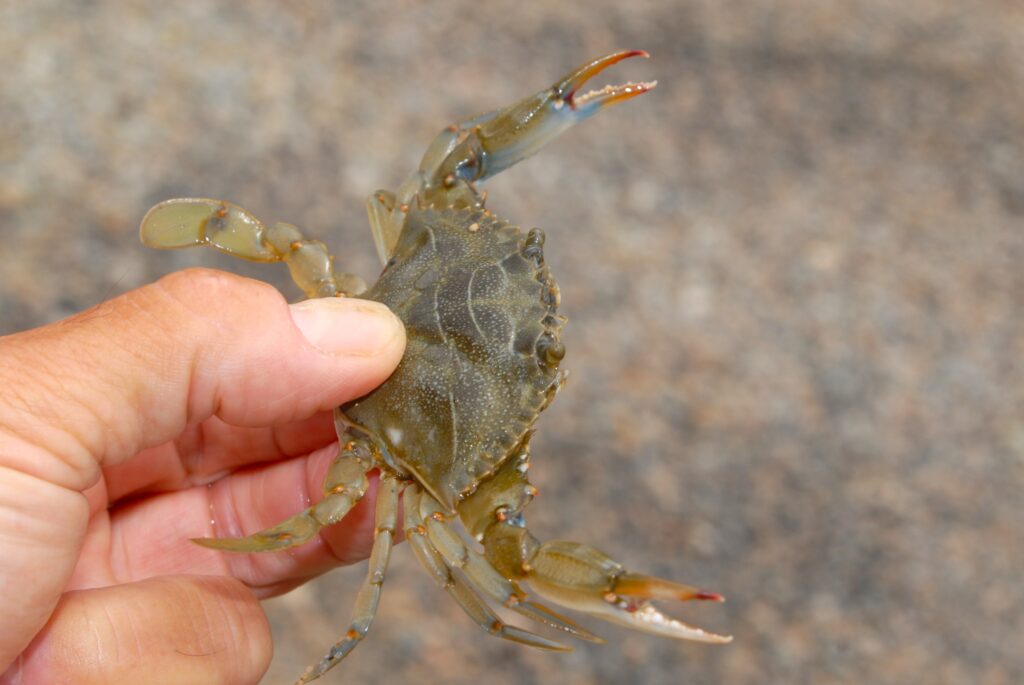

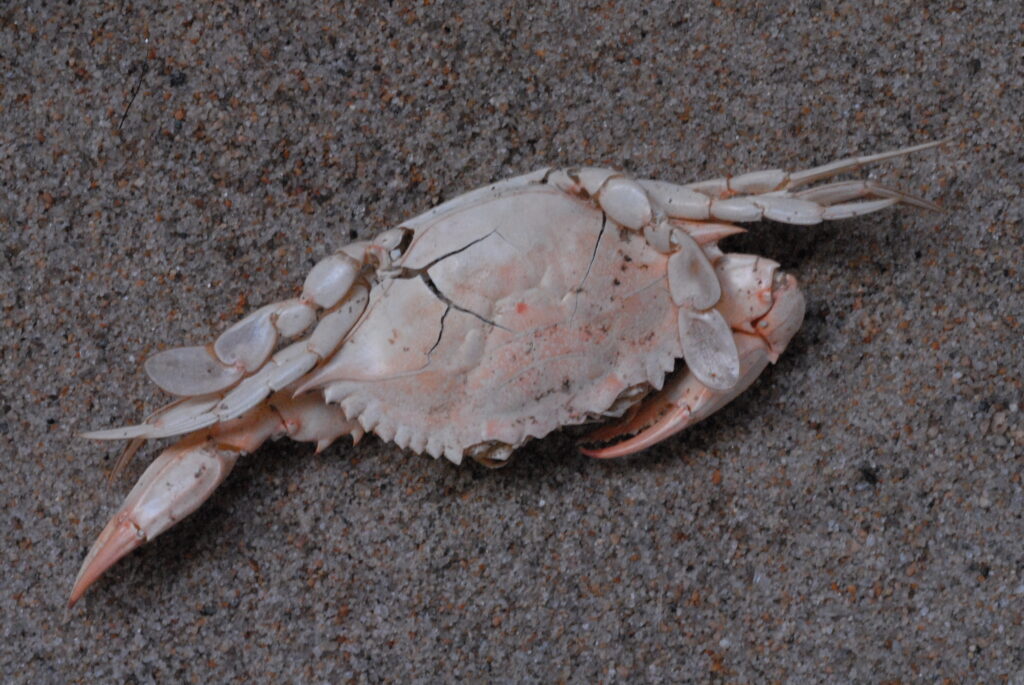
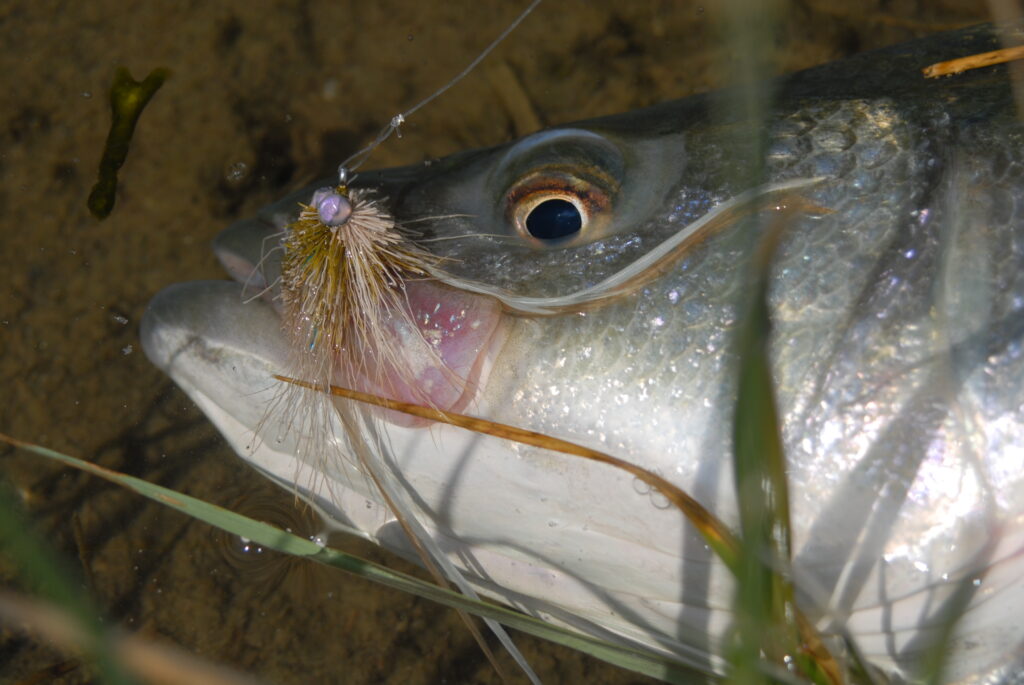
Recipe for Blue Crab Imitation
HOOK: Daiichi 2546 or TMC 811S, size 2 – 1/0
THREAD: Olive Danville’s Flat Waxed Nylon
WEIGHT: 1/20-ounce lead dumbbells, with beige coating
EYES: Burnt 30-pound-test monofilament (optional)
CARAPACE : Alternately spun tan and olive deer hair; non–pearlescent turquois Krystal Flash mixed in each spin
CLAWS: Two narrow pale blue hackles, splayed outward. Alternate Recipe: one narrow pale blue hackle and one narrow burnt orange or olive hackle splayed outward on each side of the carapace
Sparkgler (2017)
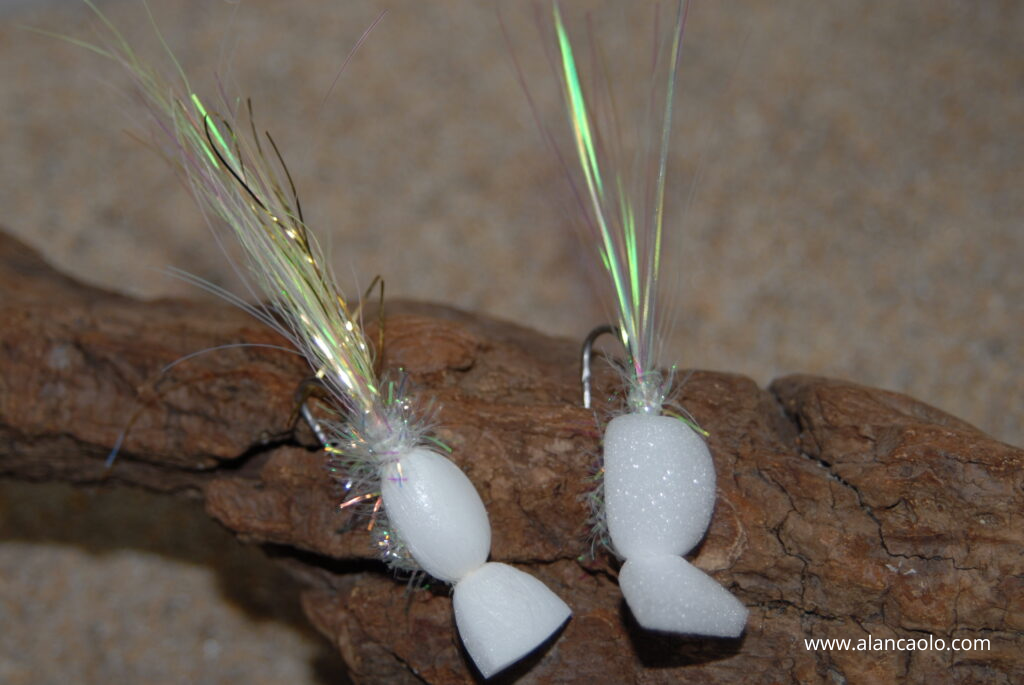
Straight-up plain truth – this is nothing more than a variant of the late great Jack Gartside’s marvelous surface bug – The Gurgler. The twist with this version is its heavy reliance on flash material – pearl flash in particular. What was the motivation for developing this Gurgler variant? I was seeking a simple fly that would entice surface strikes from false albacore . . . anyone who fishes for these small tuna needs no further explanation – the explosive surface strikes I contemplated were enough to get cracking at the vise. In further truth, the crazed visuals the spinning community were experiencing with all the new surface lures and techniques emerging for those anglers was driving me nuts . . . I wanted something similar in fly. Well, the Sparkgler succeeded – right off the bat. The strikes, however, were more subtle than explosive, but the experience is riveting and addictive, much like Atlantic salmon fishing with a Bomber.
HOOK: Daiichi 2546 or TMC 811S, size 2 – 1
THREAD: White Danville’s Flat Waxed Nylon
TAIL: Pearl Flashabou, minimal white bucktail mixed in (optional)
BODY: 1/8”-thick white Fly Foam, ½”-wide; pearl Estaz
Striper Muddler (2018)

The Striper Muddler name says it all – this is a Muddler Minnow, a classic and enormously effective fresh water streamer. Trout, largemouth, smallies, and even Atlantic salmon . . . any fish capable of taking this pattern will eat it. Modifying the classic design here and there – namely colors and proportions – produced an ideal night fly for finicky and selective striped bass. From mid-August through September, the annual silverside crop that was spawned in May and grew within protected inshore waters throughout spring and summer begins concentrating and inching its way seaward. Stripers feed on this very important forage night and day, but after dark they have their way with them; for about eight weeks it’s a reliable nightly event. This regular feeding can drive fly-rodders nuts – incessant and distinctive surface popping (often within calm waters) makes it seem easy that you’ll score with 15- to 30-inch bass. But in reality, it is not. Patient, delicate presentations that retrieve the right flies super slowly are necessary to succeed . . . the Striper Muddler cracks this code. I like fishing this event with a light 7- or 8-weight floating line, a 10-pound-test mono leader, and a two-fly set-up to avoid spooking fish in very shallow water and to increase the odds of getting my flies noticed amongst the zillions of silversides. This is night-fishing at its very finest . . .
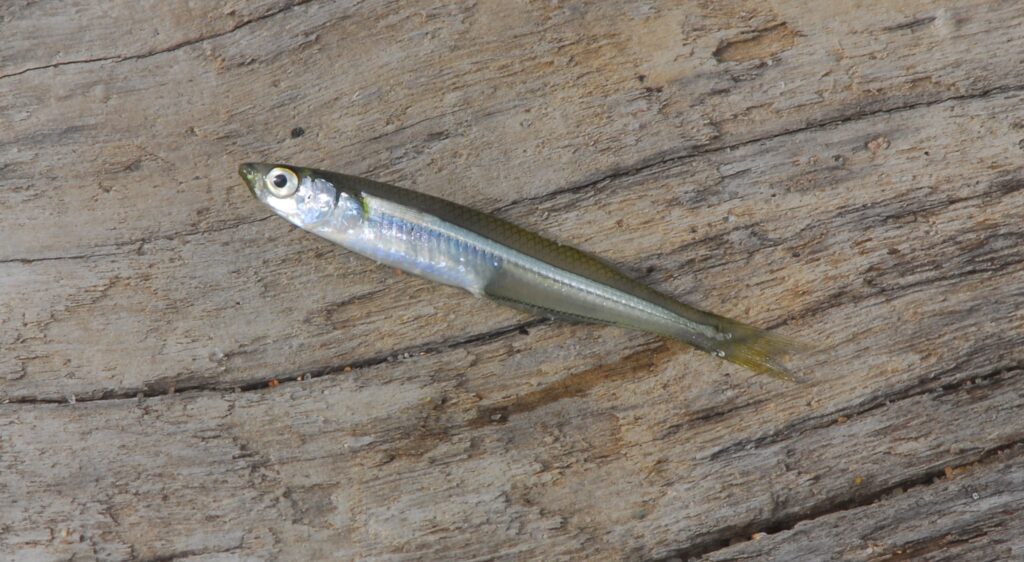
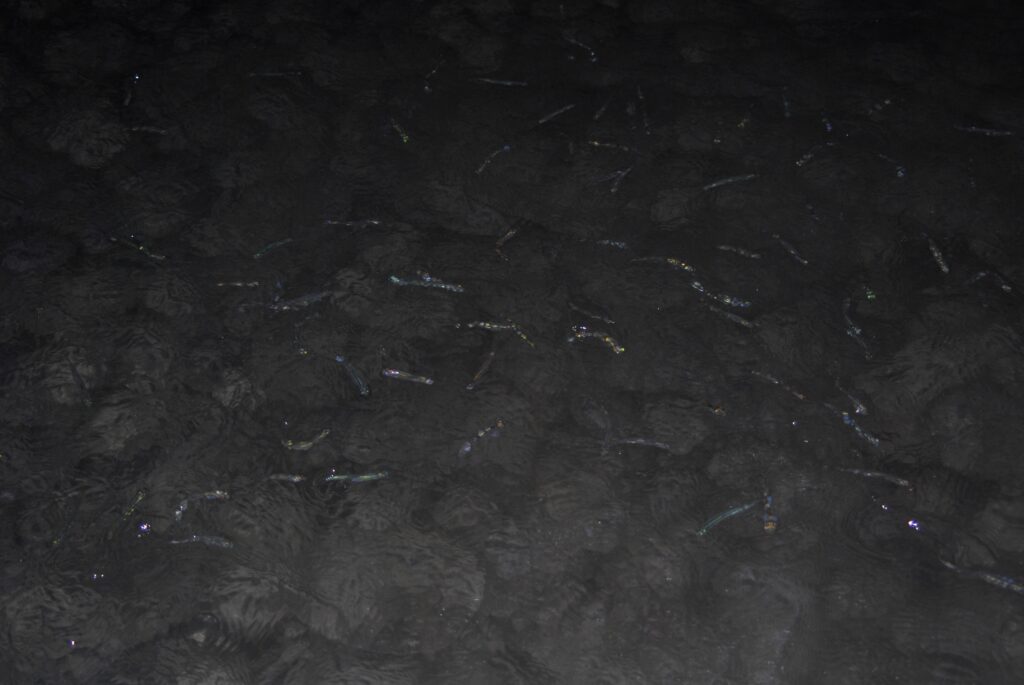

HOOK: Mustad S74SNP-DT (34011); sizes 4 – 1
THREAD: Danville’s Flat Waxed Nylon, black
HEAD: Spun black deer hair shaped to a conical head
BODY: Holographic Flashabou wrapped on hook shank, green
WING: Bucktail, primarily black over emerald, with four – six strands of holographic flash
OPTION: Insert two narrow black saddles over the bucktail wing fibers
TAIL: Tuft of very soft saddle hackle fibers, black
Snook Muddler (2024)

Another variation of the iconic Muddler Minnow, this time for snook, an outstanding flats game fish! While sight-fishing the mangrove edges on a recent trip to Belize, I discovered how challenging this great game fish is. Sharpshooting into mangrove roots and overhang to visual targets is utterly fascinating, enormously challenging and like no other fly fishing I know of . . . It’s a technical fly caster’s dream-come-true! I had been casting standard white bunny strip flies with a couple of meager “sippy” little takes with no hookups before tying on the Muddler . . . with the right presentation the strikes became ferocious. Check out a recent post entitled Gangstas in the Articles section of this site for a colorful look at this unique angling experience.
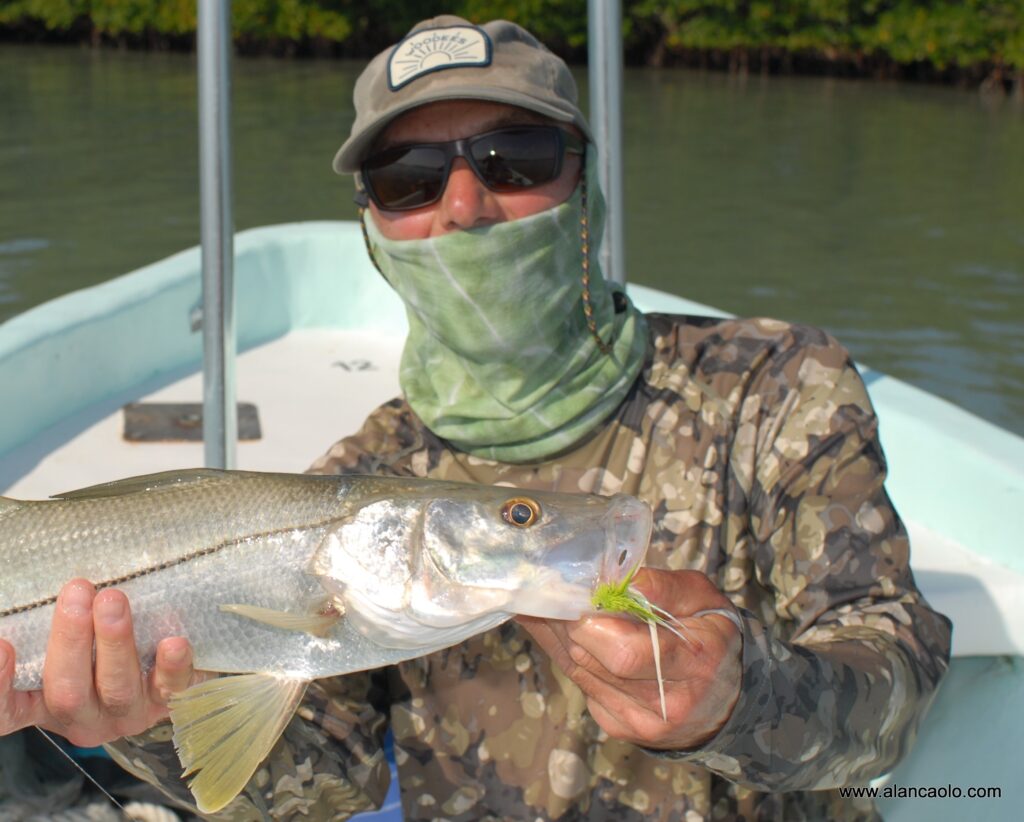
HOOK: Daiichi 2546; size 2 – 1/0
THREAD: Danville’s Flat Waxed Nylon, lime (red for a red-head Muddler)
TAIL: Four soft, narrow, slinky white saddles
BODY: Bill’s Bodi-Braid tightly wrapped on hook shank, pearl
COLLAR: White marabou (or arctic fox) on top and sides only to encase the tail saddles
HEAD: Spun bright green deer hair shaped to a conical head (red for a red-head)
FLASH: Fine POLARFLASH, pearl, nestled within the collar and matching the length of the tail saddles
Blitz Buster (2000)

The Blitz Buster is really just a Lefty’s Deceiver (thank you again, Mr. Kreh) that’s been uniquely modified to ensure it gets noticed by striped bass and bluefish in high-energy fall blitzes. While shoreline mullet blitzes are typically not too difficult to succeed in, hooking up in bunker (baby bunker, in particular) and anchovy events can be surprisingly difficult at times, especially when there are throngs of natural prey for the fish to gorge on – the Deceiver-style Blitz Buster is intended for such bunker blitzes (a Clouser-style Blitz Buster 2.0 that’s specially formulated for anchovy events appears below). What’s unique about this Deceiver is the inclusion of a bright tail structure created with orange, hot pink or red saddles, Zonker Strips, or plain bucktail, for simplicity. I favor a Zonker tail for the extra action afforded by rabbit fur. In the mammalian world, a gash to the neck or throat is often fatal and many baitfish patterns include some red feature in the gill area of the under-collar. But with filter-feeding bunker whose gills continuously flare while normally swimming, such a feature merely serves to make your fly resemble healthy naturals all the more! In the marine world of fishes, however, a tail wound spells certain death . . . it may be slow and miserable at the hands of crabs or other benthic creatures after a gradual descent to the bottom, but most often it’s immediate in the jaws of frenzied game fish within the blitz. I refer to the tail structure of these flies as a “wound feature” that powerfully suggests incapacitated and easy-to-capture prey. Dick Brown, in his highly informative book, BONEFISH Fly Patterns (2011), refers to specific fly pattern features that illicit a predatory response from bonefish (a strike) as “triggers”. The wound feature in the Blitz Buster is precisely that. I typically launch my Buster right into the middle of frenzied feeding, clear any slack out of my line, and retrieve the pattern with a very slow draw with regular long pauses, allowing the natural turbulence of the melee to impart feeble life to my slowly descending wounded bunker that is destined to die . . .

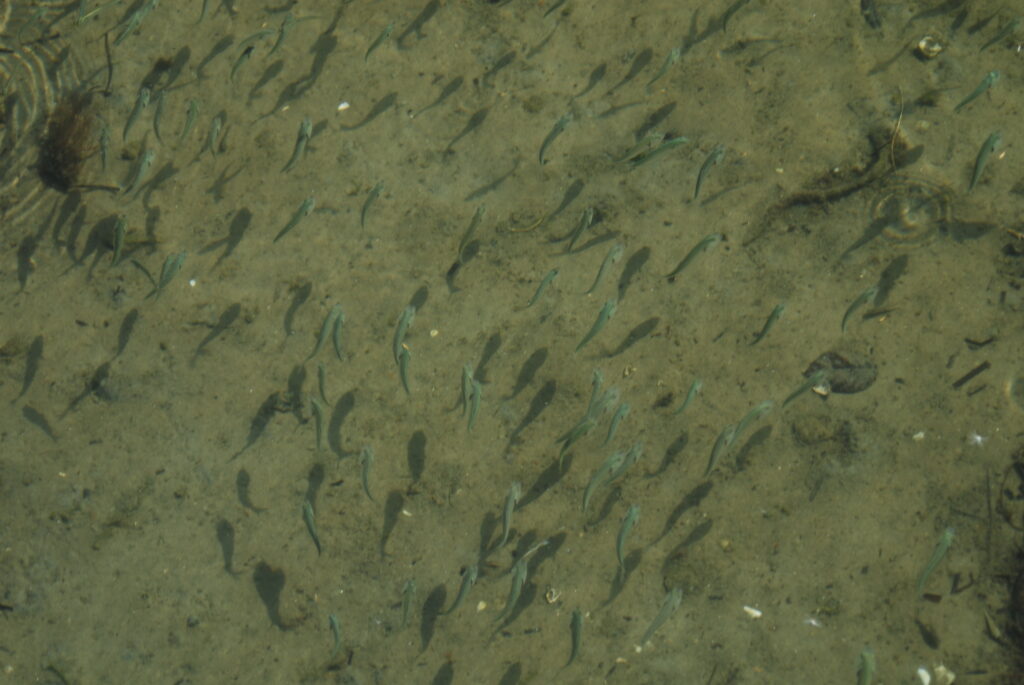
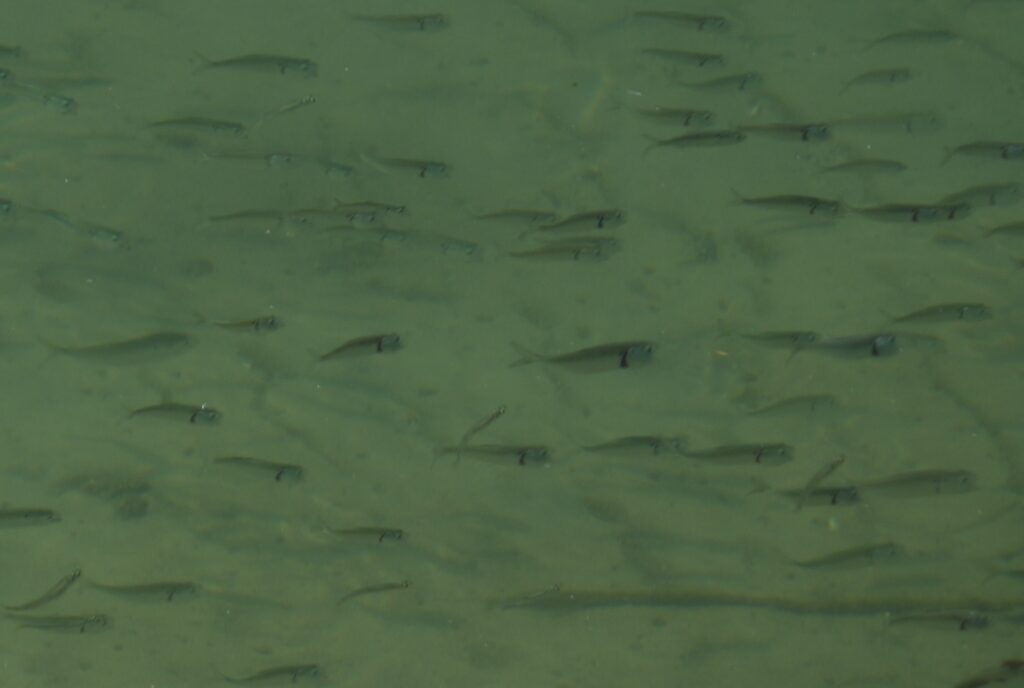
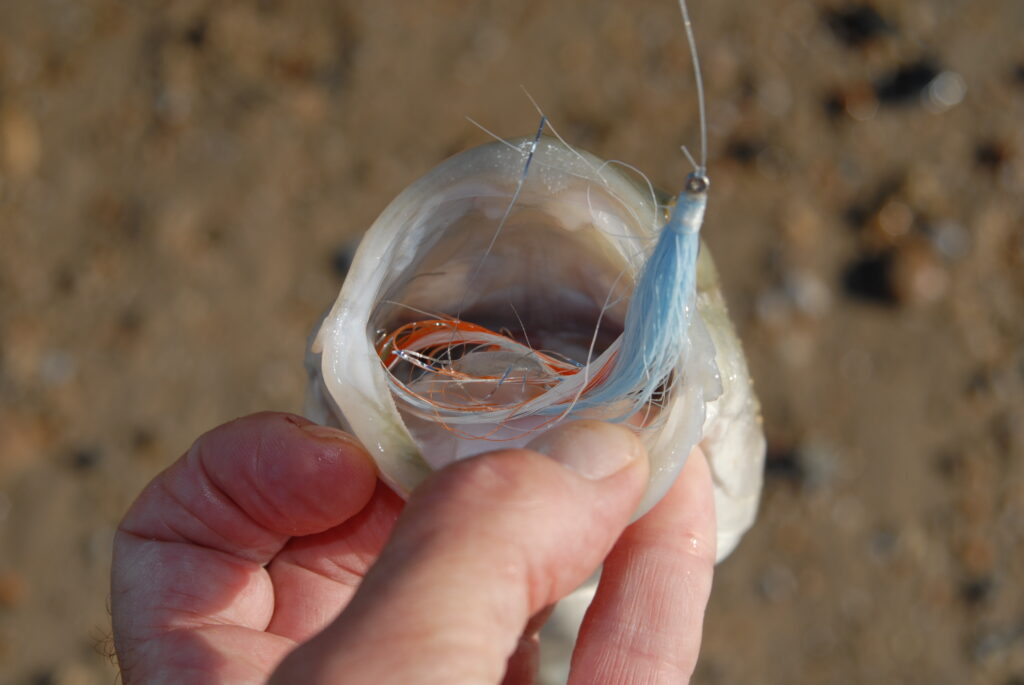
HOOK: Mustad 3407 or Daiichi 2546; size 1/0
THREAD: Danville’s Flat Waxed Nylon, white
BODY: Bill’s Body-Braid, pearl
WING/COLLAR: Bucktail, white, blue, or yellow (peacock herl topping optional)
UNDER WING: Bucktail, white
TAIL: Rabbit Zonker Strip, bucktail, or four saddles; hot pink, orange, or red
FLASH: Generous use of Flashabou within the tail and collar structure, rainbow or silver with pearl mixed
Blitz Buster 2.0 (2021)

Oceanfront anchovy blitzes are fantastic fall events for Northeast surf anglers – compared with mullet and large bunker, anchovies and sand eels are small, rather delicate prey that are easily corralled by game fish that hem them into shoreline corners and pockets (e.g., where the sand abuts beach groins, jetties, boulder fields, and other structures). Their slow-moving schools are typically large and frequently they completely stall – sometimes for days – within these beachfront features, as striped bass, bluefish, hickory shad and false albacore periodically raid them mercilessly for ultra-easy fall-run feeding until the once significant biomass is reduced to fragments, if there are any anchovies left at all.
Fly rodders generally do well in these events simply because anchovies are small prey that are readily imitated with flies. Savvy spinners, however, manage some fish, too, with small Deadly Dicks and very small teasers (often handed to them by generous fly rodders) fastened ahead of their plug or spoon. But anchovy blitzes are made to order for fly anglers.
Similar to baby bunker, the dead and wounded flail about within the maelstrom as they gradually descend to the bottom. But anchovies and sand eels are relatively tiny and usually they’re inhaled by the mouthful by hungry game, making the Blitz Buster fly concept described above less effective and it’s entirely unnecessary and there’s a much better approach. By utilizing weight in the pattern with Clouser-style lead eyes, anglers can capitalize on three concurrent phenomena: first – disabled anchovies are naturally headed to the bottom making weighted flies a sensible choice, second – by fishing your fly below the melee overhead, your fly will be separated from throngs of naturals in the upper water column, becoming more noticeable and easily singled out by the fish, and third (most important) – while bait is being ravaged high in the water overhead, other fish (particularly larger, lazier and less aggressive feeders like big stripers) often prefer to lay low and mop up the easy snacks under the blitz. The Blitz Buster 2.0 completes this strategy perfectly.
Anchovies are naturally pinkish or flesh tone, but when under duress, their schools can “light up”, appearing rather orange at times. Their backs are quite iridescent and often flicker green in the water with bright sun. I have found the chartreuse and orange color themes described in the recipes for these patterns to be effective colors, but I’m certain other colors may be substituted successfully. Further evidence substantiating the effectiveness of bright green for imitating anchovies is the green Deadly Dick, a consistently consistent go-to spoon among spin anglers when anchovies are in town. I like to pitch my Blitz Buster 2.0 right into the middle for the blitz, leave a bit of slack in the line and let the fly slowly fall to the bottom, twitching it every few seconds on the way down. If it makes it to the bottom, I slowly nudge the fly in with delicate wrist turns till it’s no longer under the blitz, but it usually doesn’t make it that far . . .
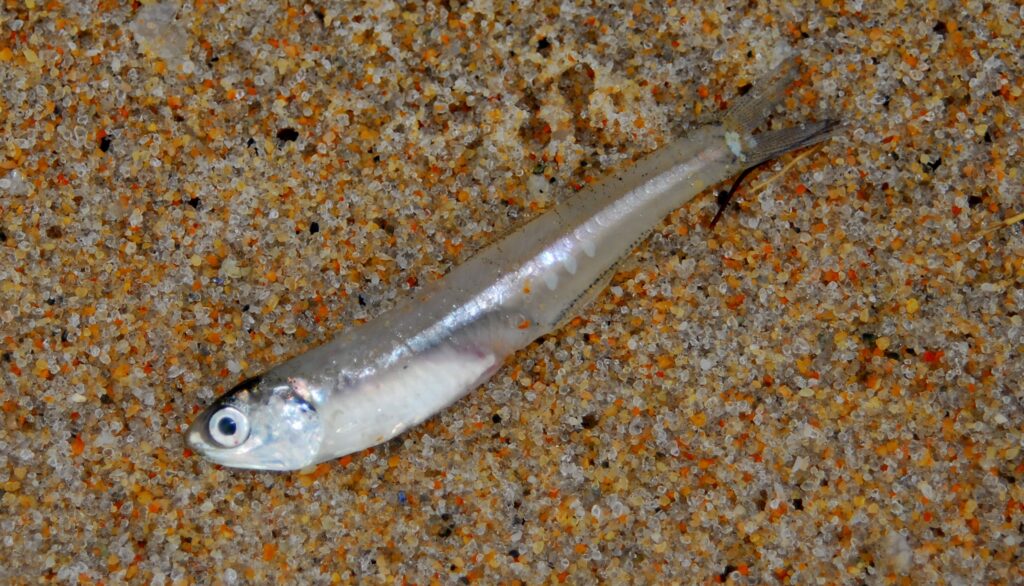
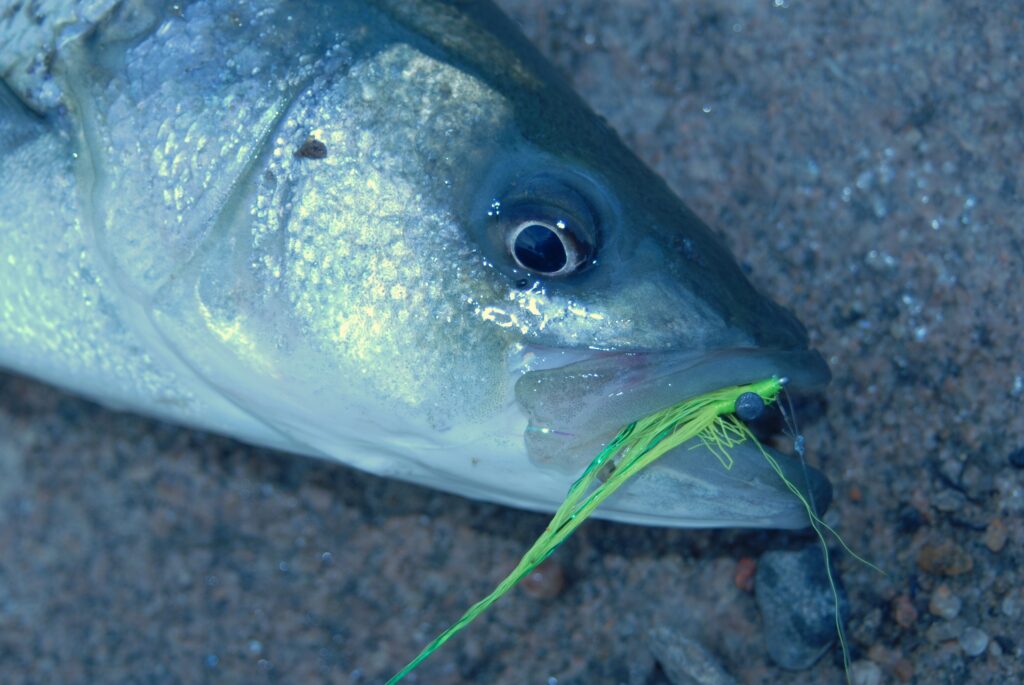
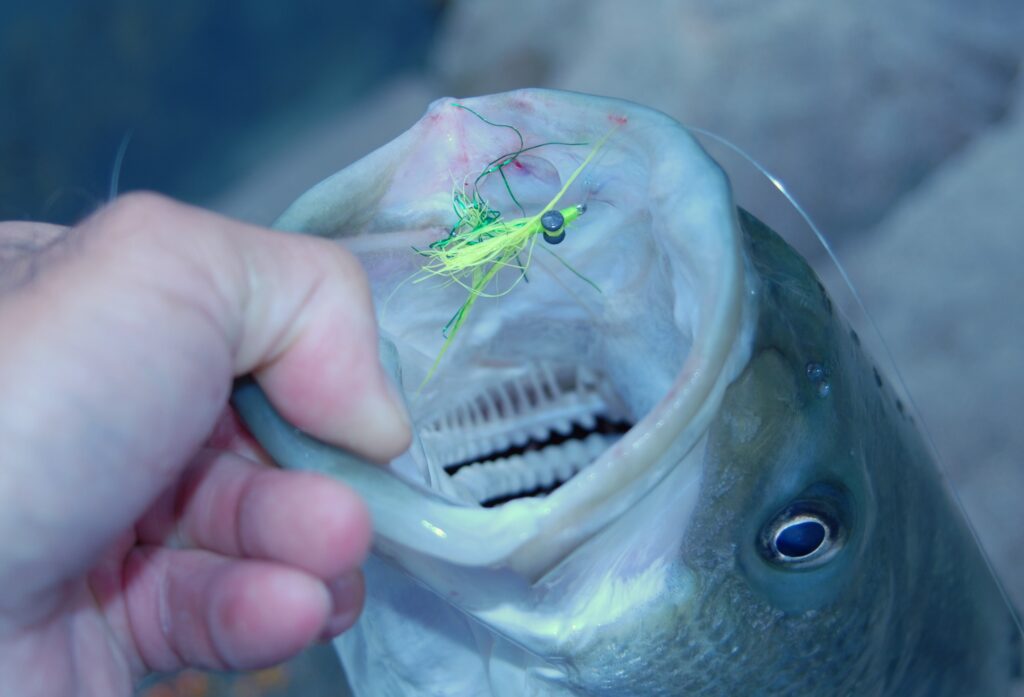
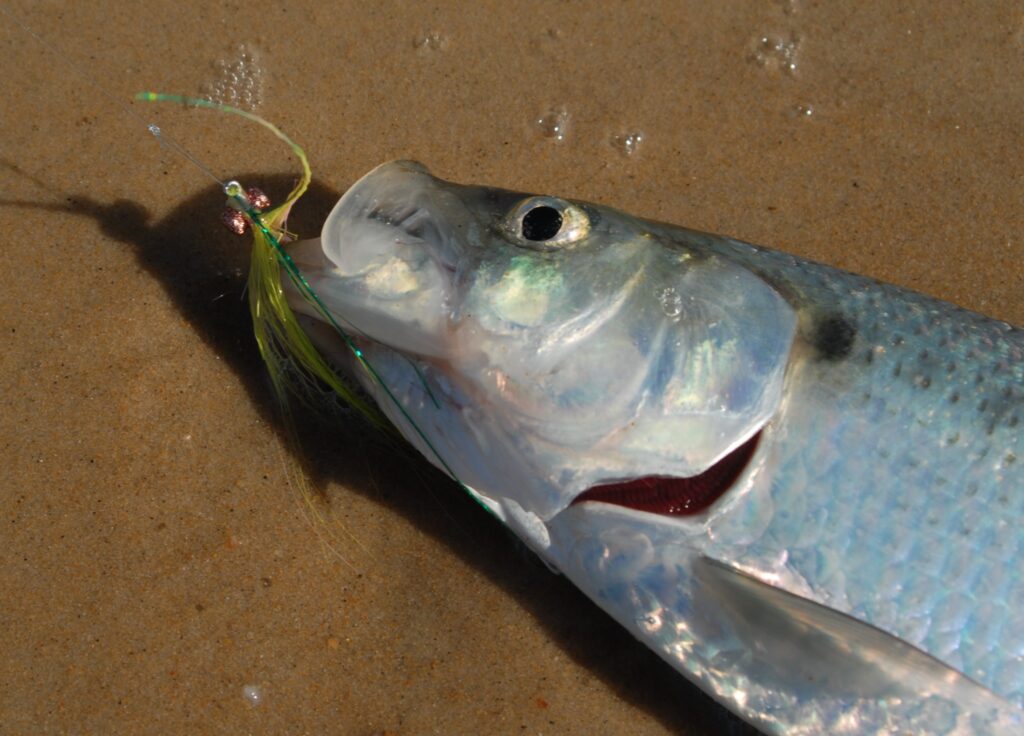
Recipe for Small Pattern
HOOK: Daiichi 2546 or TMC 811S, size 4 – 2
THREAD: White Danville’s Flat Waxed Nylon
EYES: Medium (1/30 oz) lead dumbbells, chrome or black
UNDER WING: Bucktail, chartreuse
MID WING FLASH: Generous pearl Flashabou
WING: Bucktail, chartreuse topped with two – four strands of fine emerald holographic tinsel
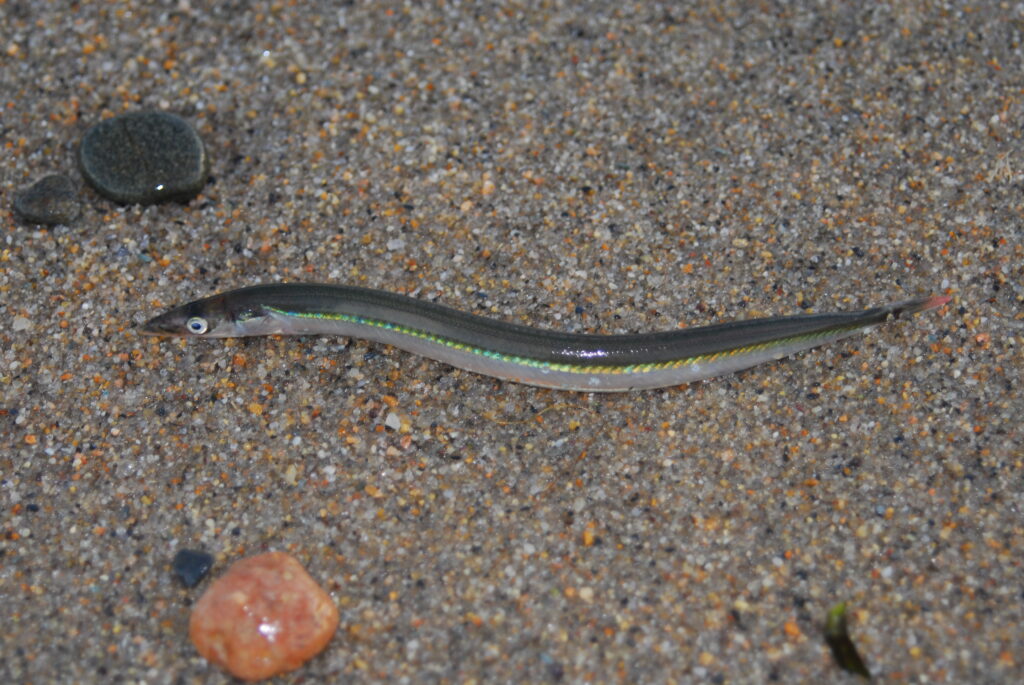
Recipe for Large Pattern
HOOK: Daiichi 2546 or TMC 811S, size 2 – 1
THREAD: White Danville’s Flat Waxed Nylon
EYES: Large (1/16 oz) lead dumbbells, chrome
UNDER WING: Bucktail, white
MID-WING FLASH: Generous red or orange Krystal Flash / pearl Flashabou mix
WING: Bucktail, orange topped with four – six strands of red Krystal Flash
Cottontail (2022)
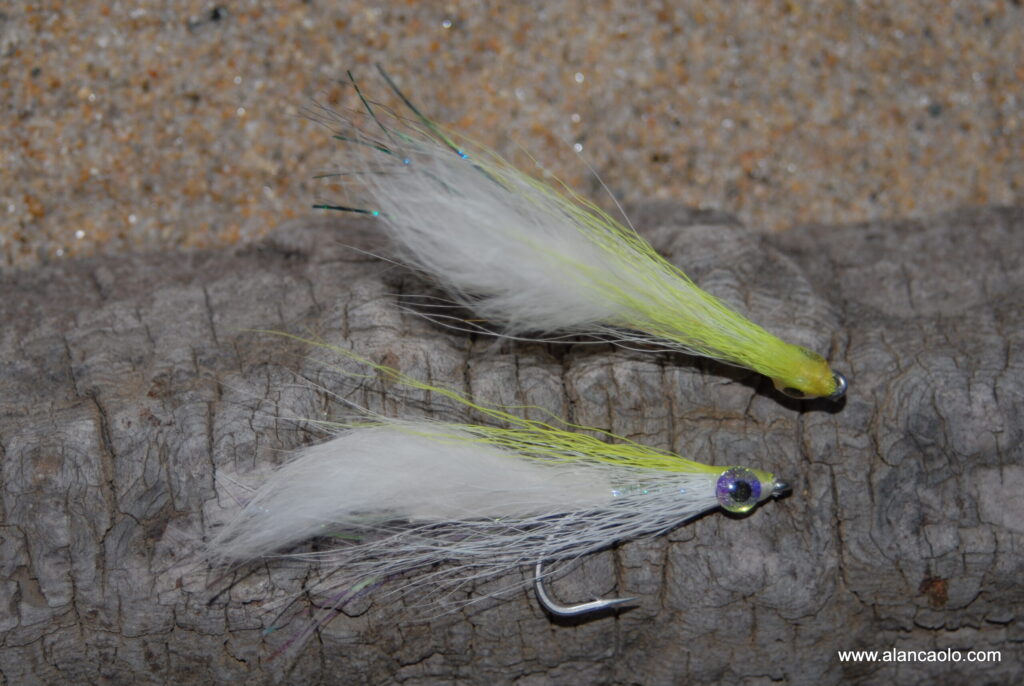
The effectiveness of rabbit fur in creating the illusion of life in a fly drove me to develop a false albacore (and bonito) pattern that’s designed around that crazy-effective natural material. My own Blitz Buster and Captain Jaime Boyle’s well-known Bonito Bunny are examples of the potency this magic material brings to a baitfish imitation. I had also had great success with small, sparse Deceivers for albies, so the idea of simply swapping out the feathers with a short white Zonker strip was the logical next step. The collar became more of a “vail” that encloses the front part of the Zonker, thus providing foul protection, while leaving that beautiful tail free to exude life, especially with the super slow retrieves I favor for false albacore (which include pauses). The collar was entirely white bucktail in early versions of this fly, but I soon modified it to chartreuse on the top, fading to white for the under-collar, so as to leverage off the power of chartreuse as a strike “trigger” in saltwater flies – it works. Now, the flash . . . albacore are powerfully seduced by the flash material in a pattern and nearly every great albie fly leans on this phenomenon. I really like delicate Flashabou for the great action it provides – a mix of pearl and silver seems to perform consistently well and I always include more pearl than silver (about 2/3 of it). So here’s a cool little feature in this pattern – instead of draping the flash all around that beautiful bunny tail, which might inhibit some action, if not lead to fouls, I opted for a method often seen in tarpon flies. When I first began fishing for them in the Florida Keys, I relied entirely on my guide for flies and leaders (and still do to a great extent – it’s just smart). His flies included some flash material, but it was rolled into these patterns like I had never seen – fastened in a clump-like fashion right at the butt of the fly, nestled within the feathers. So there was a flash feature that would be right in the tarpon’s nose and never be a foul risk – brilliant. There were probably 15 – 20 strands of flash and they weren’t chopped off straight like a “squared away” military haircut, the cut was feathered to allow this short burst of flash to effectively flicker . . . again, right in the tarpon’s face. With this concept in mind and knowing that albacore are often drawn to a fly from below, I simply utilized this tarpon fly trick by attaching a short cluster of flash over the bend of the hook, immediately underneath the Zonker Strip attachment. The combination of these ideas resulted in a small and extremely effective false albacore fly – the Cottontail – a pattern that’s part bunny fly, part Deceiver, part tarpon fly, and one that’s very easy to tie!
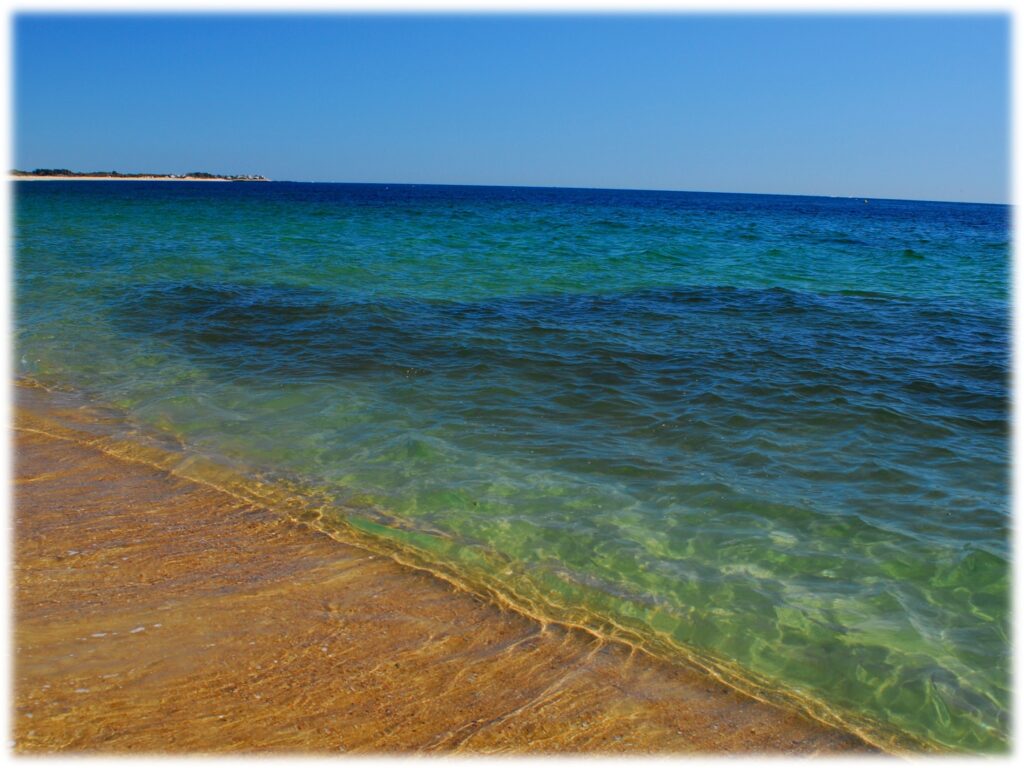

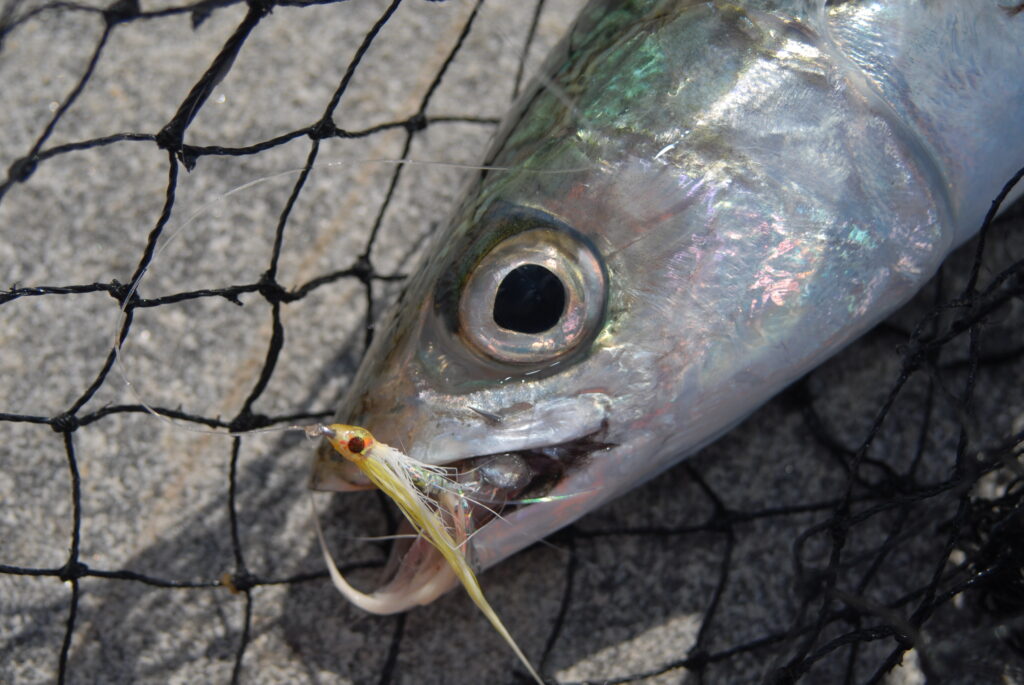
HOOK: Daiichi 2546 or TMC 811S, size 2
THREAD: White Danville’s Flat Waxed Nylon
TAIL: Rabbit Zonker Strip, white, attached over hook point; length slightly longer than the overall hook. Tail attachment is directly over generous pearl & silver or pearl & emerald Flashabou that should extend the total length of the Zonker tail fibers
BODY: One strand of holographic tinsel wrapped over hook shank from over the barb to the eye
COLLAR: Bucktail, white, extending back 2/3 the length of the Zonker Strip tail
WING: Bucktail, chartreuse, to match collar length
Flash Bomb (2022)
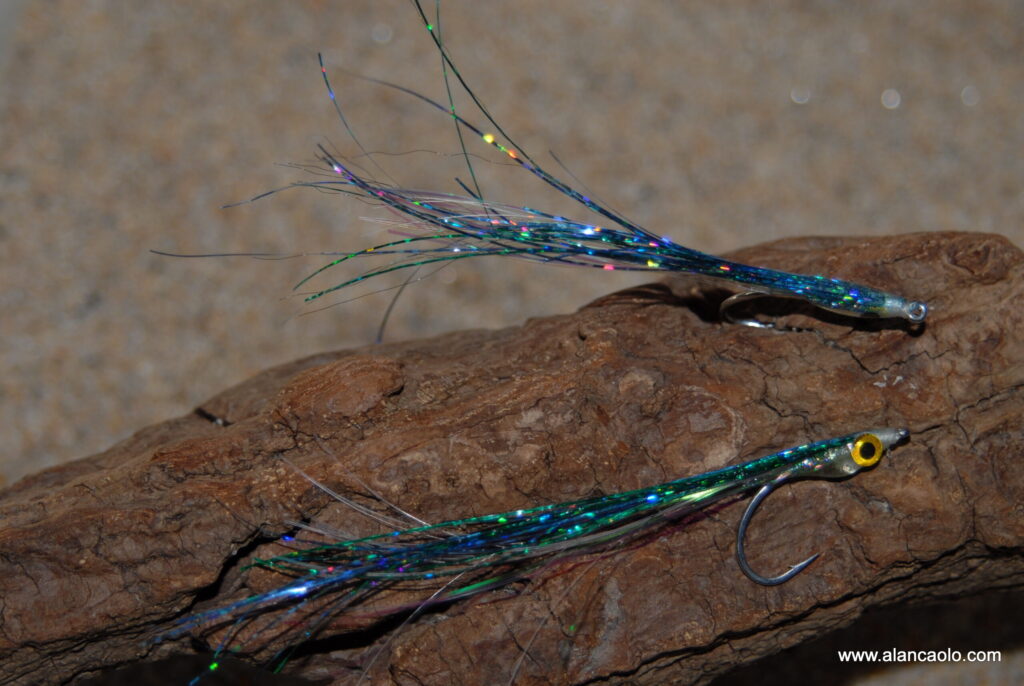
This fly is obnoxious . . . it’s the perfect pattern for game fish that just can’t have enough flash in their flies. I believe we include too much flash in many of our mainstream saltwater patterns when a more muted appearance is often more effective. With flats patterns (especially for striped bass and educated bonefish), I typically exclude sparkle entirely, as bottom dwelling prey aren’t very flashy creatures (compared with most minnows and certain shrimp). But with false albacore, you can’t put too much flash into the pattern . . . they love it! So, starting with a traditional epoxy minnow in mind I thought why not make the whole damn thing out of flash material? The Flash Bomb was the result and it proved itself immediately. I play a bit of hockey these days and the young men that dominate that scene describe slick puck-handlers as Dirty (they’re hilarious!). If they fly fished, they’d say the Bomb was Filthy : ) The combination of a hefty hank of pearl Flashabou for the tail, a body consisting of wrapped holographic flash, and a wing entirely composed of fine holographic tinsel – all held together with two light coats of clear epoxy – the Flash Bomb is slim and it ignites in the water, radiating a mesmerizing sparkle that’s visible at astounding distances on sunny days. Albacore regularly come from 20 feet away to inhale it, often requiring utensils for extraction . . . In all likelihood, Flash Bombs will be dynamite on barracuda, as well.
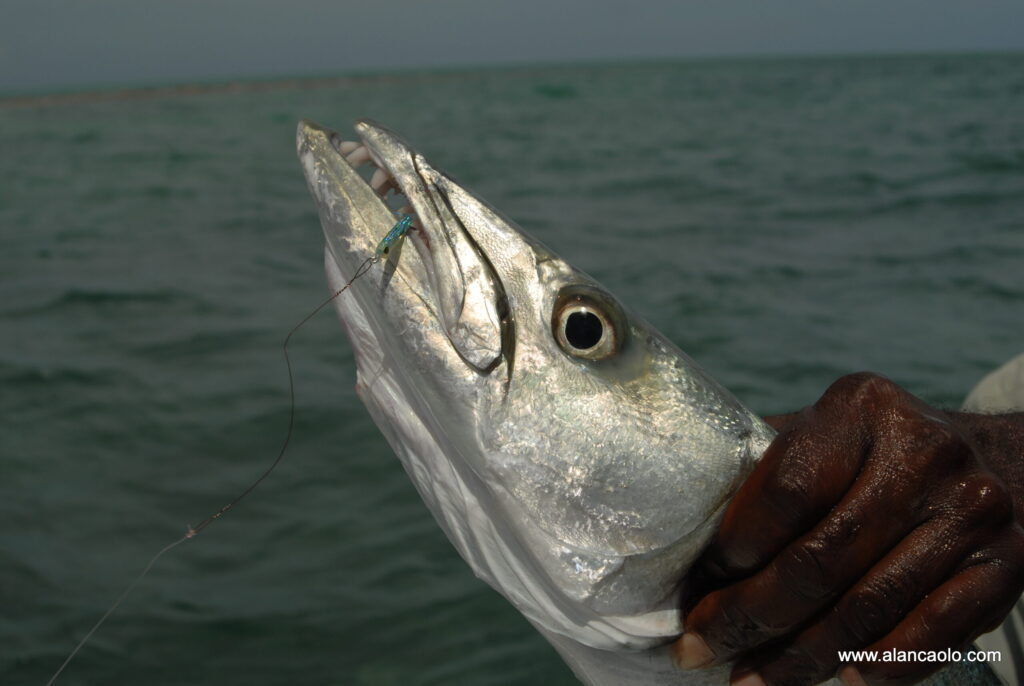
HOOK: Gamakatsu SC-15, size 1
THREAD: White Danville’s Flat Waxed Nylon
TAIL: Generous pearl Flashabou attached over the hook point, extending back about three times the length of the hook
BODY: One strand of thick holographic tinsel wrapped over hook shank from over the barb to the eye
WING: About 10 strands of fine pale blue holographic tinsel over four or five strands of fine emerald holographic tinsel attached just behind the hook eye – emerald length to match the pearl tail, pale blue tinsel at various lengths to create a “feather duster” look that will generate A LOT of sparkle in the water
COATING: Two light coats of Devcon clear five minute epoxy resin only back to a point over the hook bend. Foil prismatic eyes appropriately positioned between epoxy coats
Belly Dancer (2023)
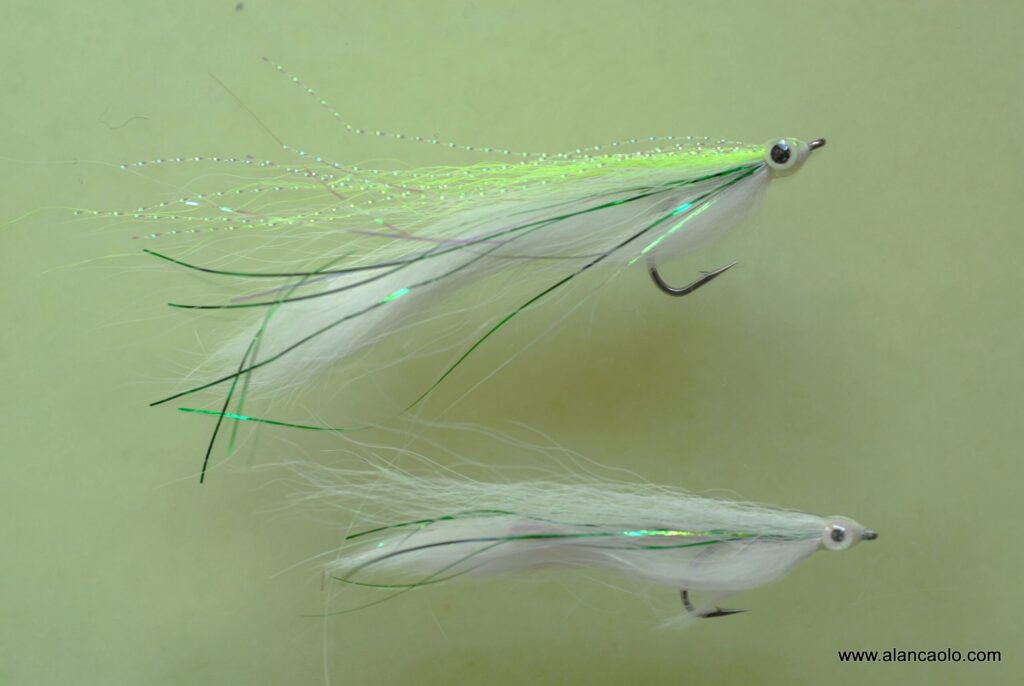
On the heels of the success of the Cottontail for false albacore, I thought I’d explore another pattern in the bunny fur genre, perhaps a bit longer and hopefully even more consistently effective for both false albacore and Atlantic bonito. In addition to lengthening the fly, the most significant twist with this new design was inverting the attachment of the Zonker Strip, positioning it on the underside of the hook shank (where the hook bend is) rather than on top, as with the Cottontail. I also purchased some “Micro Rabbit Strips” from Hareline to develop this pattern. The Belly Dancer can mimic a silverside, a sand eel, but most importantly – a big juicy bay anchovy. Little tunny love anchovies, which can sometimes prove difficult to imitate. The Micro Strips produce a noticeably slimmer pattern that closely resembles the thin (side-to-side) bodies of bay anchovies. Standard Zonker Strips will surely work, but a narrower fly profile when viewed from below is better, as I’ll describe.
Keeping in mind that game fish feeding on bait most often spot, approach and devour their prey either from below or behind the baitfish. I believe the appearance of a fly from these vantages is most important, especially when targeting highly discerning gamefish, such as false albacore. The narrow bunny fur Micro Strip produces a realistically slim imitation and its inverted attachment as an “underwing” on the underside of the pattern ensures a mesmerizing undulation that’s going to be right in the albie’s grill. What I like a lot about the Dancer is that it can be retrieved very slowly, even completely paused, during the retrieve, which is highly advantageous after you’ve pitched your fly to a good spot among actively feeding albacore. Your fly has the highest probability of being grabbed when it’s in front of surfacing fish, or in amongst them within a “high octane” feeding zone. Albacore are reluctant to chase individual escaping baitfish and prefer to stay in high gear and blast the prey immediately in front of them. So, when I sense my fly’s in a good spot within the action zone, I bring it slowly . . . oftentimes letting it hang motionless in the melee. The Belly Dancer is made to order for this tempered approach (I never sensed that screaming a fly through the water at high speed is an effective approach, as it can be for spin casters). The mesmerizing underwing keeps the fly looking alive even when it’s a sitting duck, suspended motionless immediately in front of the fish.
Other than the underwing attachment, this is a simple pattern to tie. I favor a mix of pearl and emerald Flashabou when imitating anchovies and sand eels, and all pearl for silverside impressions.



HOOK: Daiichi 2546 or TMC 811S, size 4 – 2 (upper fly above is size 2, lower fly is size 4)
THREAD: White Danville’s Flat Waxed Nylon
UNDERWING: White Micro Rabbit Strip attached to the underside of the hook with length about three times the overall hook length. The Rabbit Strip is easily perforated on its centerline with by the very sharp hook point and slid around the bend for a proper smooth & straight, “uncrumpled” positioning under the hook shank. The Strip is neatly snipped at the hook eye with a Vee-shaped cut and fastened down with thread
MID-WING: Six to 8 strands each of pearl and emerald Flashabou evenly mixed and attached to the top of the hook shank. A loop-style foul guard formed with 15- or 20-pound-test clear monofilament may be included in the mid-wing atop the hook shank (immediately below the flash material) to mitigate fouling of the slinky underwing on windy days
WING: White bucktail with length to match the Rabbit Strip underwing. The wing may optionally be topped with chartreuse or pink bucktail (or both) and 10 – 12 strands of pearl Krystal Flash to enhance visibility
HEAD: Finish with head cement, attach Small-Silver F-C Decal Eyes (or equivalent) and lightly coat with Devcon 5-Minute Epoxy
Cinderella (2024)
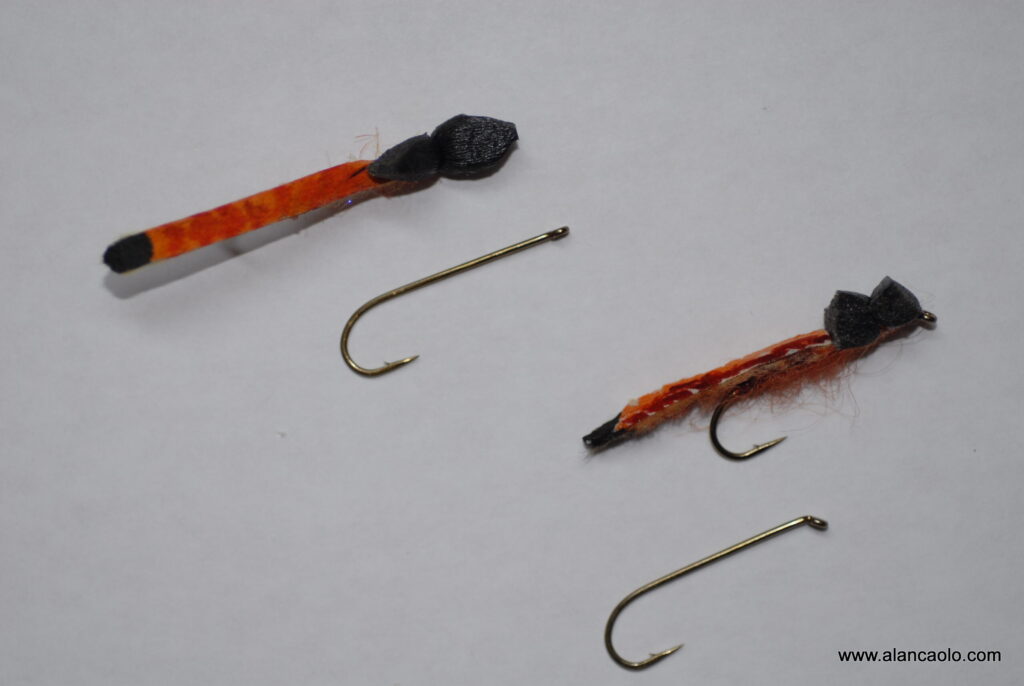
Northeast cinder worm events are both challenging and fun to fish. Even when the bites are hard to come by, it’s always an exciting visual surface feeding experience and a great time to rendezvous with fellow fly rodders for some early season action. There’ve been many cinder worm patterns developed and most of these flies are successful at least some of the time, some are duds that just look great in the vise, and others are fairly reliable and succeed most of the time. But I’ve yet to find a cinder worm imitation that nails it every time and everywhere . . . when I do, I’ll coin it the Unicorn. Till then, I’m sticking with my confident go-to worm patterns and enjoy the challenge of hooking up in these crazy events like everyone else. Over the last few seasons, however, I’ve developed another “go-to” cinder worm, the Cinderella . . . and she’s a charm!
As with many of my creations, I wasn’t specifically setting out to develop another worm fly – I stumbled onto an idea at the desk, became curious, spun up a rough prototype that would test the fly’s key features, hit the hatch, and voila . . . I had a new pattern under development. Cinderella proved irresistible to the fish on that first outing, but she was not exactly dolled up and ready for the ball . . . she needed some polish. I’m generally not too concerned with a fly’s appearance in the vise. I’m very concerned with how well it fishes, how well it casts, and the ease with which it is tied. Early Cinderella prototypes looked like they emerged from Dr. Frankenstein’s laboratory, however – nothing smooth nor attractive about them. From there, I strived to groom this little gem so she would look more presentable to anglers, without compromising what the fish clearly found enticing. This was a challenge . . . The finished pattern is not all that different from the original effort – I dressed up the foam head a bit and neatened the body construction. That’s about it.
I believe the tail is what’s special with this fly. Gazing over my tying desk one day, some leftover bare rabbit strips (having been cut clean while experimenting with dubbing loops) caught my attention – they looked vaguely worm-like. The question was could I use them effectively in a new worm fly. Cinder worms propel themselves in a peculiar fashion – they don’t wiggle about like little eels, instead they swim by activating the myriad short filaments located along their sides, much like how a paramecium uses its cilia. The result is they dart about the surface with a rather straight-line body posture (like little twigs dashing about), rather than in a serpentine fashion.


The short rabbit hides tied flat to the back of the hook shank precisely mimicked this, as they resist a side-to-side undulation. Colored markers were ideal for creating a worm-like appearance on the hide – banded bright orange and rust markings and a black tip at the tail created a winning look. The black foam head serves to mimic the black head typical of most cinder worms and it adds buoyancy to the pattern. Depending on the length of hide used and the size and gauge of the hook, the foam head may or may not support the fly on the surface (I favor light-wire bronze freshwater streamer hooks for delicate, surface-working cinder worm flies) If it does, great – it’ll create a tiny wake as the fly is retrieved, which the fish often key in on. If not (most of my Cinderellas do not float), the foam makes the fly nearly neutrally buoyant – it neither sinks, nor floats. And that’s mighty effective, too, as evidenced by the consistent success this pattern has demonstrated throughout several worm events. The fly’s body (under the hide) needed some accent along the hook shank. I found rust or ginger sparkle dubbing to be a simple and effective choice and it appears to enhance the fly’s “fish-appeal” even more.
I’m not a fan of gluing flies together, but the floppy hide strip needed some hold-down to retain the stiff-looking worm-like locomotion. A small bead of Gorilla Super Glue down the back of the hook (right over the dubbing) followed by pressing the hide down firmly on the glue with a stretched pull back and down till the glue sets and a dab of head cement finishes the fly. Cinderella may look a bit dumpy, but she’s a princess for sure . . .
HOOK: Daiichi 1750 or 2220, size 4 – 6
THREAD: Black or rust Danville’s Flat Waxed Nylon
TAIL: A short length of rabbit strip (either Zonker or Cross-Cut) with the fur stripped off leaving a clean, smooth length of hide. The hide is colored top and bottom with waterproof pens (Sharpies are perfect) with a distinct black tail-tip and the remaining strip banded orange and rust
BODY: Plain rust or ginger brown sparkle dubbing
HEAD: Thick black fly foam (typical Gurgler material) attached at the eye of the hook with either a simple square “chunk”, or cut and streamlined with a diamond or other creative shape
NOTE – Captain Ray Stachelek of East Greenwich, Rhode Island was helpful in the development of Cinderella. His coaching in the use of freshwater tying materials and techniques and his insight on managing pattern weight and buoyancy are valuable and appreciated.

Gotcha Special (2024)
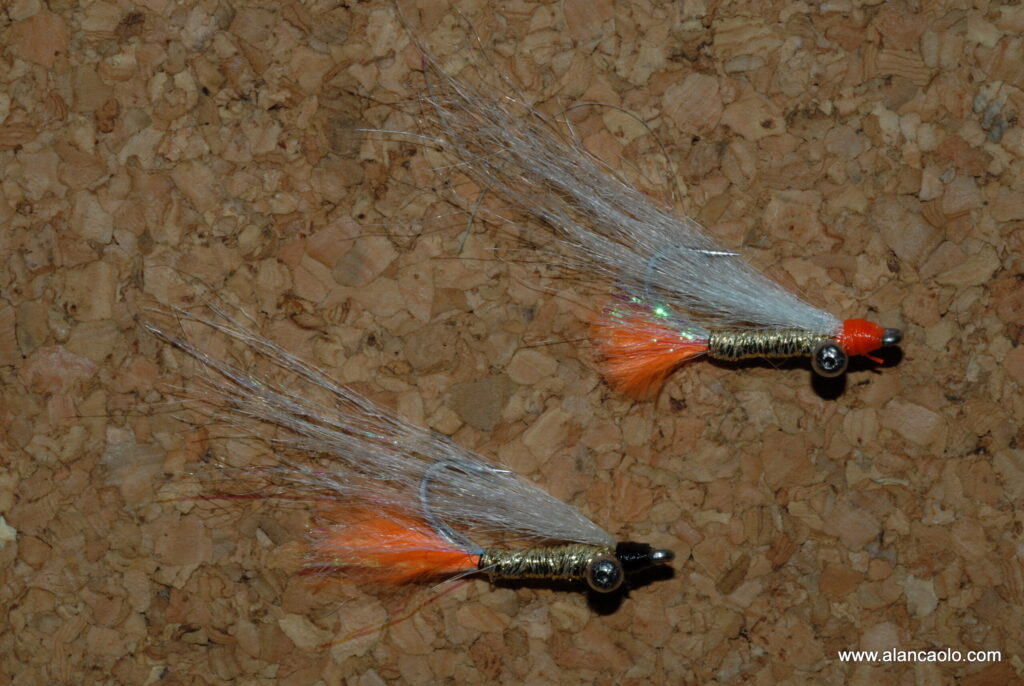

Tying flies in preparation of destination angling is a big part of the trip excitement . . . and anticipation. And it’s fun to tie out of your comfort zone. Tying unfamiliar flies for exotic species like bonefish, permit, tarpon, snook, snappers and others not only expands your fly tying acumen, it stimulates your creativity. While prepping for a recent trip to central Belize, the very detailed list of recommended flies provided by the outfitter and lodge included two notable patterns for bonefish – the Gotcha (no surprise there) and an oldie that seldom appears on such lists these days – Chico Fernandez’ Bonefish Special, a classic pattern that’s every bit effective today as ever.
While I’m spinning my trip flies it occurred to me that the Gotcha and the Special could easily be combined into a unique new bonefish fly that leverages off the distinct features (strike triggers) found in these two iconic patterns. What specifically did I like in each fly? I love the orange egg sac off the hook bend of the Special, I really like a bit of gold in a bonefish fly intended for fishing sand flats and the Special’s gold body wrap provides that, and its black thread-head reflects a classic look. While the much more recent Gotcha features weighting (either beadchain or lead dumbbells) – a very important facet for many bonefishing situations, a fine synthetic wing that provides translucence that’s both natural and enticing, and the pattern has a bit of flash – fine pearlescence within the wing and standard Gotcha pearlescent sparkle tail. The result is a simple new bonefish fly that fits the framework of contemporary bonefish patterns and it’s quick and easy to tie.
Thread color can be switched from black to fire orange depending on the look you like. Orange is a great accent for many flats game fish the world over. I like either color for the Gotcha Special and I caught fish in Belize with both versions. I’m completely confident this fly will catch bonefish in Florida and The Bahamas, as well. Some final thoughts – as with many small saltwater patterns (size six and smaller), a thread finer than Danville’s (210 denier) often produces a better result with sharper, more refined detail. But Flat Waxed Nylon will work and it’s tough and hard to break. I also think that gold beadchain eyes, rather than standard silver, would be a nice fit for this fly and would complement the gold body wrap well. A light coat of nail polish to effectively kill the beadchain’s shine is always an option when fishing pressured bonefish flats with extra wary fish.
HOOK: Daiichi 2546 or TMC 811S, size 4 – 8
THREAD: Black or Fire Orange Danville’s Flat Waxed Nylon
EYES: Medium or small bead-chain with a pale sand nail polish coating
(intended to match the flat’s bottom coloration)
TAIL: A short puff of orange marabou encased with frayed
pearlescent body braid (or piping) of equal length
BODY: Gold Bill’s Bodi-Braid
WING: Off-white or crème Craft Fur (or equivalent), four strands of fine
pearlescent POLARFLASH
FlukeNado (2024)
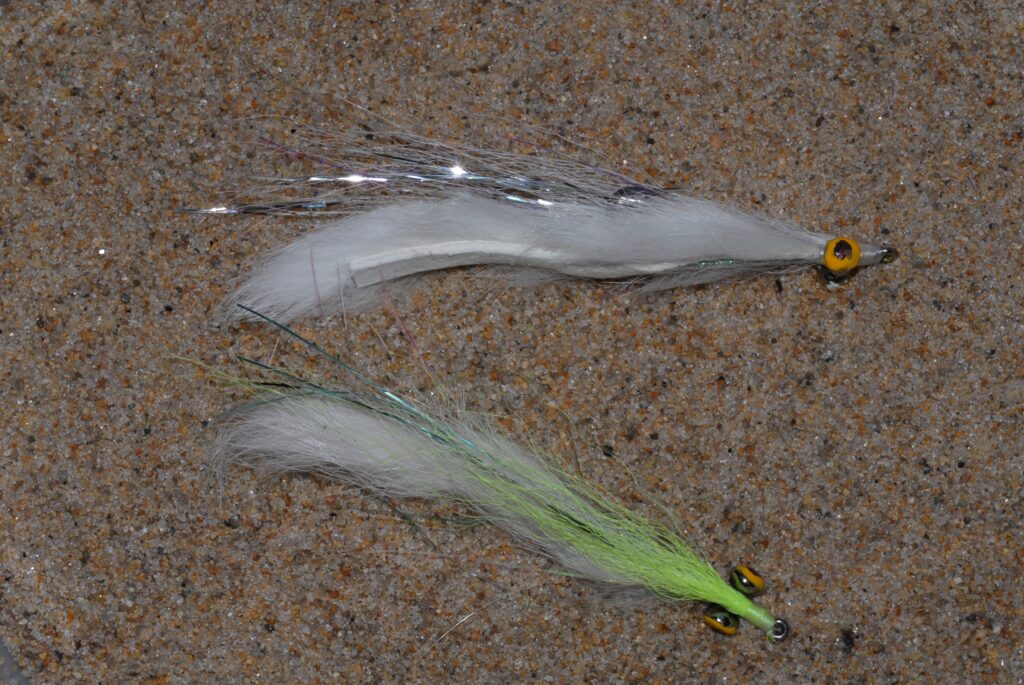
I began pursuing summer flounder (colloquially know as “fluke” in New England) in 2013, about 10 years ago. I was interested in catching them on foot, from shore. Not an overwhelming challenge, but likely harder than most people think. A fast-sink-tip fly line (3 – 5 inch per second sink rate) fished on a mushy, slow action (soft tip) seven- or eight-weight rod seemed logical (fluke, like weakfish and seatrout, have delicate mouths, which hooks can easily tear from making soft-tip rods ideal). The fly of choice was a Clouser Minnow . . . a heavy one. This tackle, along with a long-handled landing net and a waterproof measuring tape (flounder are of very high commercial and recreational interest with length regulations that vary state-to-state and year-to-year), proved to be all I needed and I caught fluke pretty much right off the bat. They are territorial and aggressive benthic creatures that ambush prey and chase small baitfish, similar to striped bass, bluefish and other upper water column game . . . fluke are game fish. Summer flounder devour squid, crabs, tinker mackerel, shrimp, sand eels and other small baitfish. A heavily weighted, bright and flashy Clouser was a logical place to start, as it sinks quickly into the fish’s feeding zone, its obnoxious appearance catches the attention of these aggressive fish, and it mimics the small baitfish they prey on.
But I had to refine the approach and try to improve my results. Fishing location and preferred tides proved to be most relevant – clearly. But I’m a tyer and I had to develop a solid fluke fly that was fun and easy to tie, fun to fish and one that consistently fooled the fluke, putting an occasional keeper flounder in the game bag (there’s no barb-mashing with this fly). FlukeNado was the result – a heavy, gaudy Clouser-style fly that’s durably constructed on a long shank stainless hook and packed with life-like movement. Fluke went bonkers over it . . . I’m not crazy about gluing flies together, but the delicate pearlescent hook shank Bodi-Braid wrap was prone to fraying and coming undone (remember, this fly drags over sand bottoms, frequently ticking stones and other abrasive objects), which ultimately ruins the fly. The remedy was a coat of clear 5-minute epoxy, but other glues or UV resins will surely work. But clear epoxy also added additional weight, which I liked. While incorporating the epoxy to the FlukeNado design, it occurred to me that the long hook shank was an ideal platform for adding even more weight – a side-by-side wrap of lead wire along the shank overwrapped with tying thread and encased in a Bodi–Braid wrap. The hook shank is then coated with clear epoxy. Fluke are flatfish that live right on the bottom – most of the time. But, they will occasionally chase bait right to the surface – they’re savage creatures. I like a lot of flash in this pattern, preferably equal mixes of silver (or pale green) and pearl Flashabou – you want the dominant territorial fluke on the bottom you’re fishing to see the fly and shove the small ones out of the way as they come and get it . . . I have consistently noticed that when fishing a good fluke spot, the size profile of caught fish successively declines, with the first one being invariably the biggest, dominant fluke. This is counter to what we typically experience with a mixed-size group of striped bass, where the smaller, more aggressive fish race to the fly ahead of the larger slot and slot+ fish (slot referring to the length range defined for a recreationally-caught “keeper”, presently 28 to 31 inches in most Atlantic states). This results in a size profile of caught fish that typically ascends from small to large – opposite to that of fluke – with little guys dominating early, and the bigger (more careful) fish making it to the fly later in the feeding event.

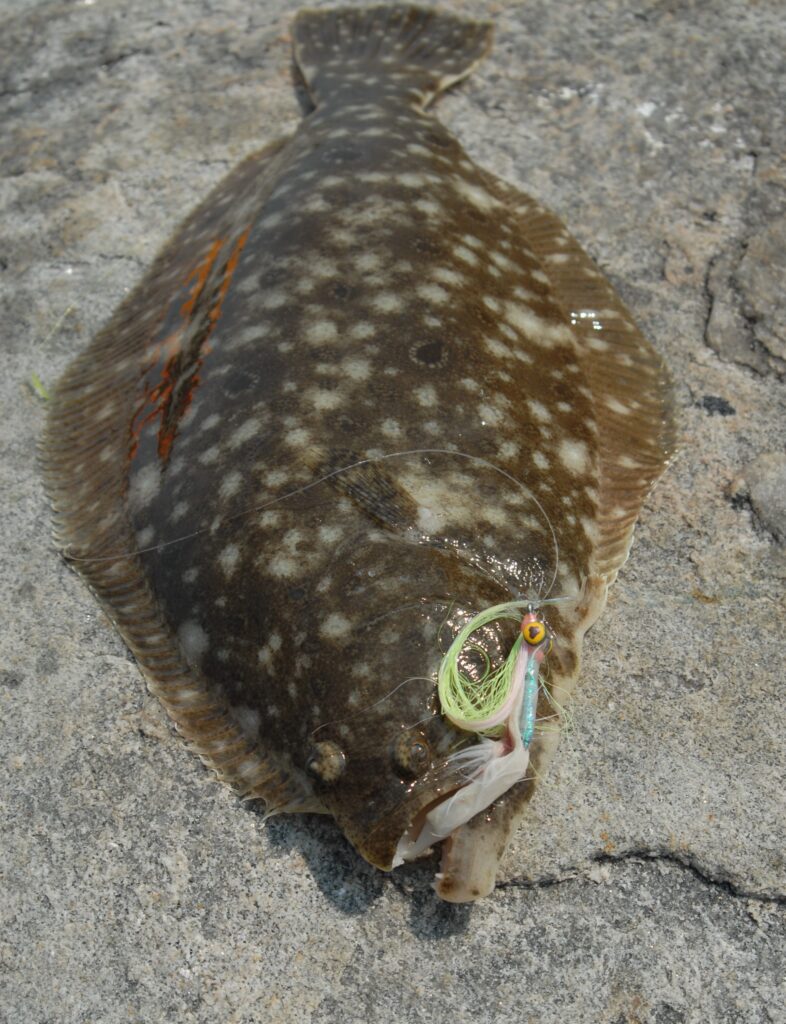
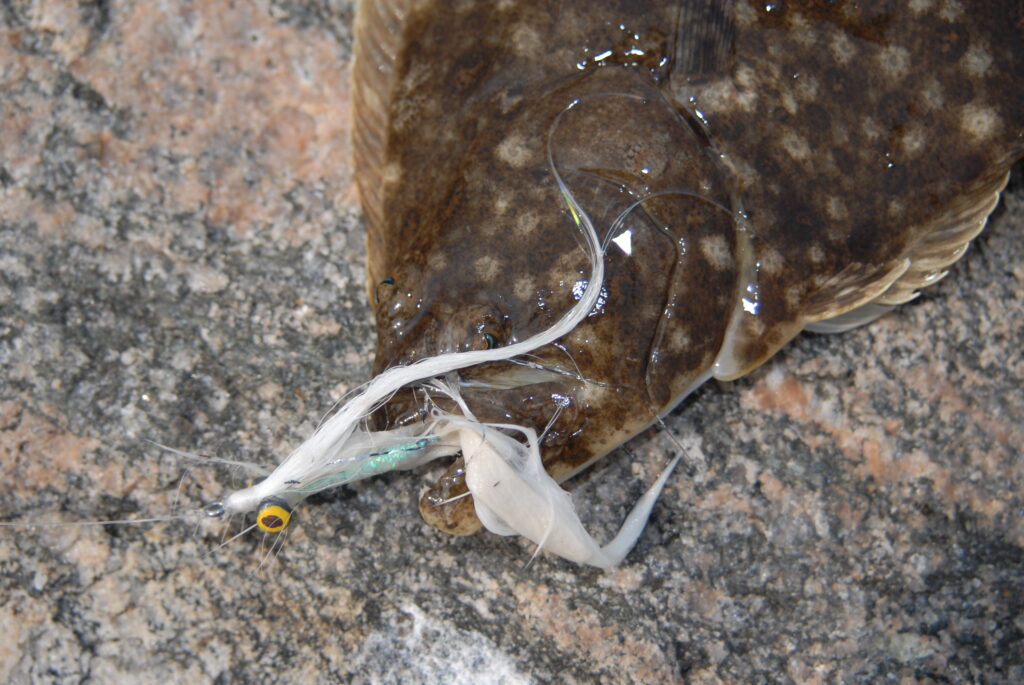
HOOK: Mustad 34011 long shank. Size 2 – 1
THREAD: White Danville’s Flat Waxed Nylon
EYES: Large lead dumbbells (1/20 oz, chrome or black) coated with bright yellow nail polish and black, purple or other dark pupils
BODY: Pearl Bill’s Bodi-Braid (marketed by Murphy’s Fly Box) tightly overwrapped over lead wire wound on the hook shank from a point directly across from the barb to just behind the dumbbell attachment. The leaded, long hook shank “chassis” is lightly coated with clear two-part 5 Minute Epoxy (Devcon) for additional weight and a more fly (remember – when fished properly, FlukeNado is bounced and dragged over sand, stones and other bottom debris
MID-WING: White Magnum Rabbit Strip about twice the overall hook length attached to the hook-point side of the hook. The Rabbit Strip is perforated on its centerline by the sharp hook point and slid around the bend for smooth & straight “uncrumpled” positioning on the hook shank (the rabbit fur will be on the top of the fly, as the Clouser-style lead eye attachment on the back of the hook shank inverts the fly to ride hook point up). The Rabbit Strip is neatly snipped at the dumbbells with a vee-cut and fastened securely with thread. Six to 8 strands each of pearl and silver Flashabou blended evenly and attached over the Rabbit Strip. A loop-style foul guard formed with 20-pound clear monofilament may be included in the mid-wing atop the Rabbit Strip (immediately below the flash material) to prevent the slinky rabbit mid-wing from fouling on windy days
WING: White, chartreuse or pale pink bucktail (or a blend of these to your liking) with length about ½- to 1-inch shorter than the mid-wing. The wing may be lightly topped with 10 – 12 strands of pearl Krystal Flash to further enhance visibility in deep or turbid waters
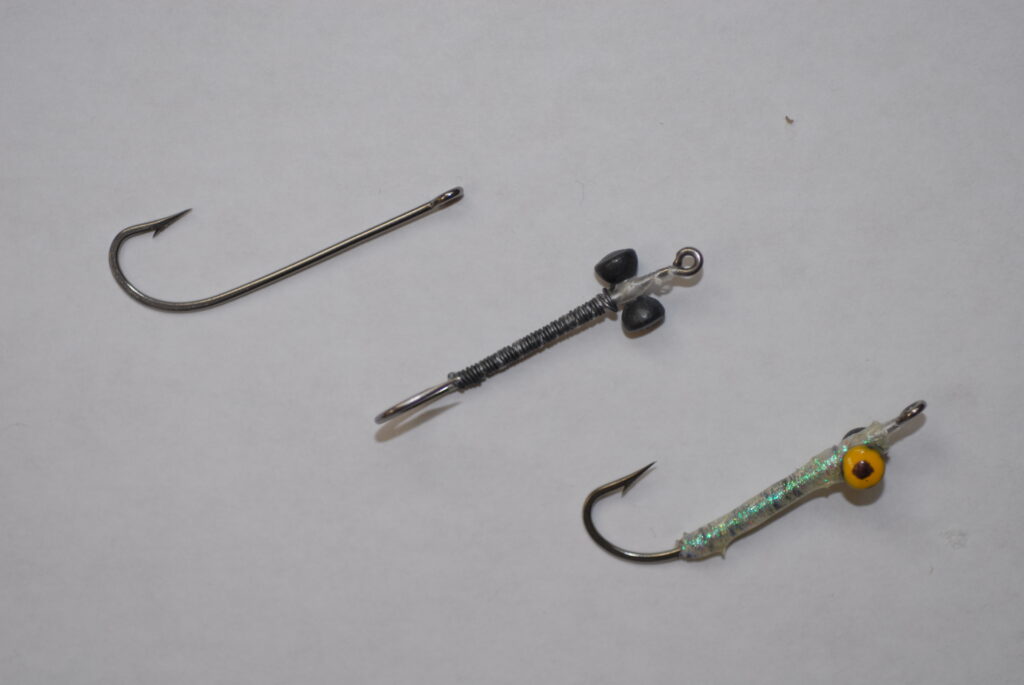
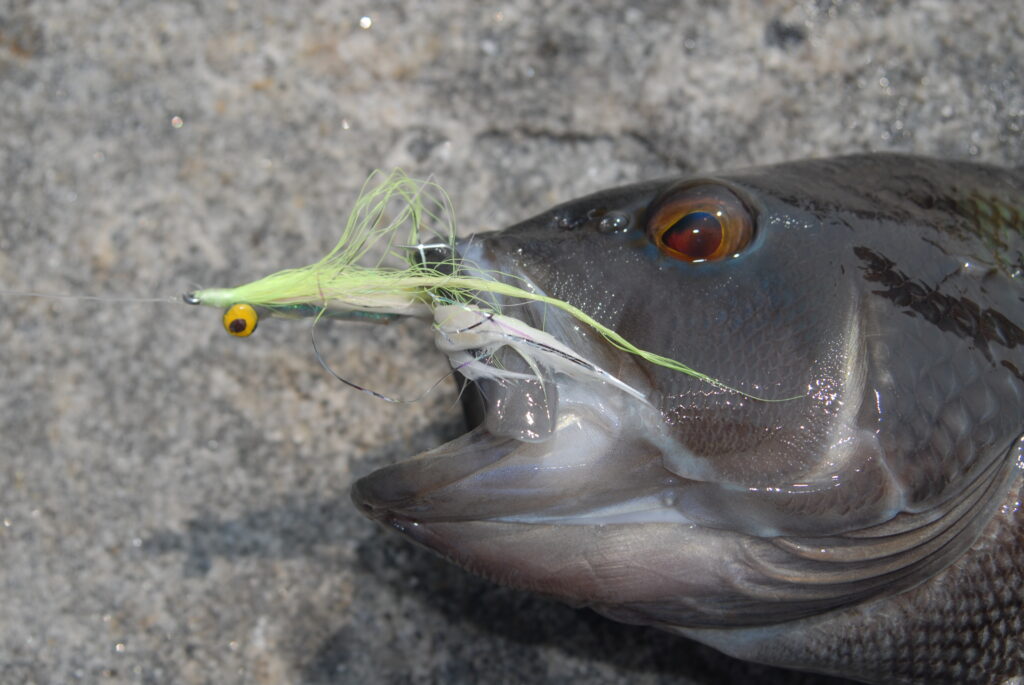
Wispy Worm (2025)

Not just another worm pattern . . . another very simple and very effective cinder worm imitation that’s about as consistent as it gets for fooling striped bass during spring worm events. Freshwater streamer hooks are again the preferred hook style due to their light weight and stealthy bronze finish, both of which complement small, delicate surface-working fly designs that imitate cinder worms so very well. I prefer an overall fly length of about three inches, which is readily achieved with a size 6 streamer hook, but flies that span two- to four-inches-long will fool the fish, as worm spawns contain a wide range of cinder worm lengths. The deer hair selected from the back of the bucktail is in large part hollow and buoyant (similar to deer body hair) and it effectively supports construction of delicate surface flies. The sparse, mildly flared deer hair wing supports the illusion of a small, wispy cinder worm darting about the surface film.


The Wispy Worm may be tied with or without a buoyant foam head – both are effective. A black foam head, however, allows the fly to stay right on the surface, tracing a conspicuous and enticing wake throughout the retrieve. Both head designs should be fished on floating lines with a fine eight- to 10-pound-test monofilament leader to ensure the pattern rides on or very near the surface with little encumbrance-to-movement commonly encountered with heavier 12- to 16-pound-test leaders that are often chosen for salt water. As with most cinder worm imitations, retrieves should be tempered and erratic to mimic the chaotic behavior of these small, delicate prey (observing the worms while there’s still adequate light, or with a flashlight after dark, provides ideal guidance for your retrieve). As with all worm fishing, expect the takes to be sippy and subtle. With adequate light, you’ll see the eat, but resist quick, aggressive strikes (especially “trout sets”) and instead simply continue your retrieve until you feel the fish upon which you’ll draw a tempered strip-strike to secure the hook-up. Remember the hook you’re fishing – it’s fine-wire, sharp, and sets with just a gentle strike.

HOOK: Daiichi 1750, size 4 – 8
THREAD: Black Danville’s Flat Waxed Nylon
WING: Rust, red or bubblegum bucktail cut from the back of the tail at a length to produce a wing about twice the overall length of the hook when attached behind the eye of the hook. The hairs from the back of the tail (near its base) are hollow, buoyant and possess very slight natural curvature that lends itself to creating a concise worm-like shape. Just two strands of black or red Krystal Flash are nestled within the wing
BODY: Plain rust or ginger sparkle dubbing
HEAD TYPE 1: Thick black fly foam (typical Gurgler material) attached immediately behind the eye of the hook with either a simple square “chunk”, or cut and streamlined in a diamond-like or other creative shape
HEAD TYPE 2: Black or sable calf’s tail attached just behind the eye of the hook with butts facing forward to create a tapered, rather than blunt head of the fly


